Restaurant Case Study: Morrison's Dilemma and Strategic Analysis
VerifiedAdded on 2023/04/24
|29
|15744
|420
Case Study
AI Summary
This case study, "Morrison's Dilemma," examines the challenges faced by a Caribbean restaurant in Toronto aiming to enhance its profitability and long-term sustainability. The restaurant, despite positive customer feedback and recognition, seeks to refine its product-service mix, blending Caribbean cuisine with French culinary techniques. The case prompts an analysis of key issues, including market positioning, competitive dynamics, and strategic decision-making to determine the optimal path for Morrison's restaurant to achieve its business goals. The case study also provides marking rubrics for effective analysis. Desklib provides students with access to this and many other solved assignments.
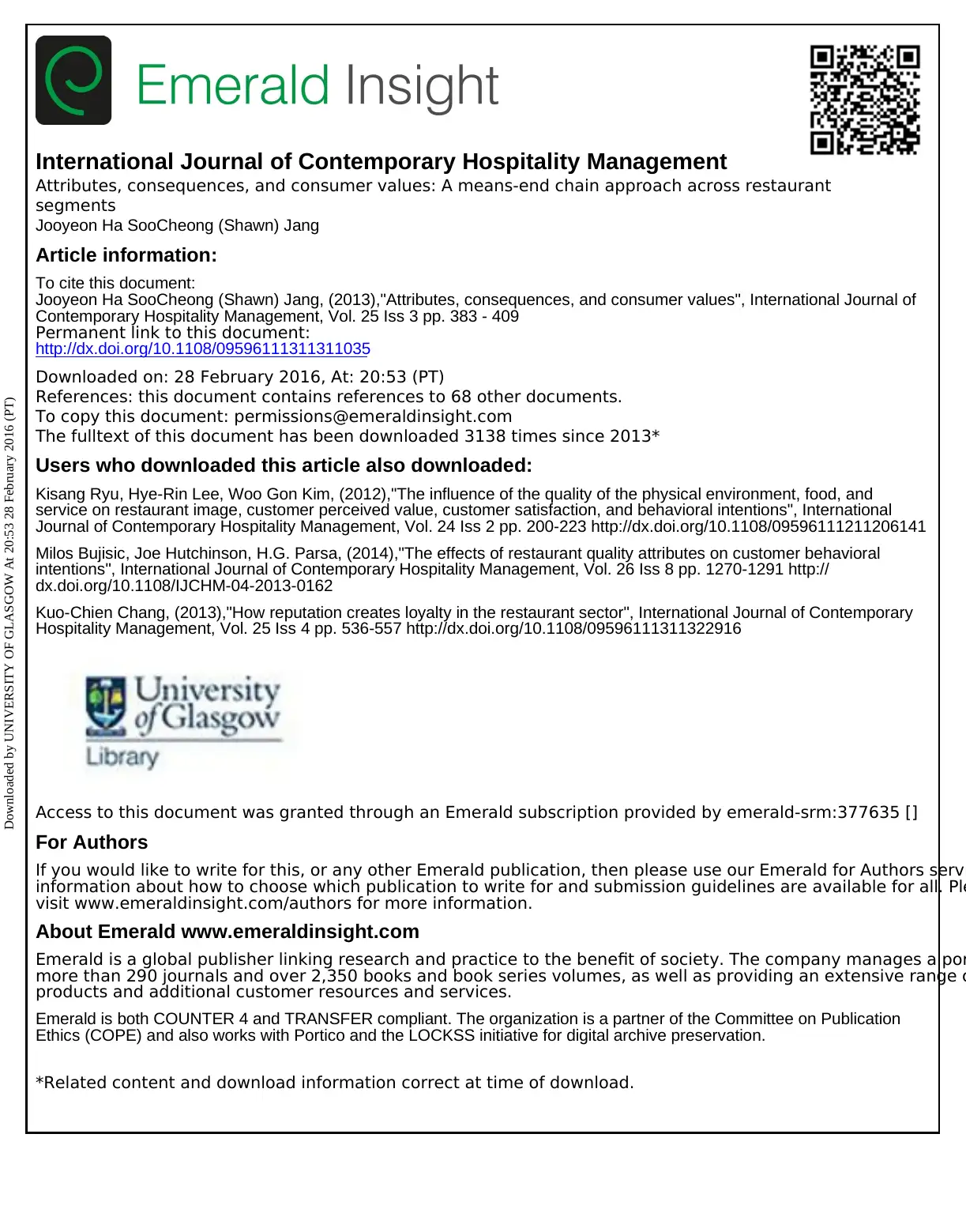
International Journal of Contemporary Hospitality Management
Attributes, consequences, and consumer values: A means-end chain approach across restaurant
segments
Jooyeon Ha SooCheong (Shawn) Jang
Article information:
To cite this document:
Jooyeon Ha SooCheong (Shawn) Jang, (2013),"Attributes, consequences, and consumer values", International Journal of
Contemporary Hospitality Management, Vol. 25 Iss 3 pp. 383 - 409
Permanent link to this document:
http://dx.doi.org/10.1108/09596111311311035
Downloaded on: 28 February 2016, At: 20:53 (PT)
References: this document contains references to 68 other documents.
To copy this document: permissions@emeraldinsight.com
The fulltext of this document has been downloaded 3138 times since 2013*
Users who downloaded this article also downloaded:
Kisang Ryu, Hye-Rin Lee, Woo Gon Kim, (2012),"The influence of the quality of the physical environment, food, and
service on restaurant image, customer perceived value, customer satisfaction, and behavioral intentions", International
Journal of Contemporary Hospitality Management, Vol. 24 Iss 2 pp. 200-223 http://dx.doi.org/10.1108/09596111211206141
Milos Bujisic, Joe Hutchinson, H.G. Parsa, (2014),"The effects of restaurant quality attributes on customer behavioral
intentions", International Journal of Contemporary Hospitality Management, Vol. 26 Iss 8 pp. 1270-1291 http://
dx.doi.org/10.1108/IJCHM-04-2013-0162
Kuo-Chien Chang, (2013),"How reputation creates loyalty in the restaurant sector", International Journal of Contemporary
Hospitality Management, Vol. 25 Iss 4 pp. 536-557 http://dx.doi.org/10.1108/09596111311322916
Access to this document was granted through an Emerald subscription provided by emerald-srm:377635 []
For Authors
If you would like to write for this, or any other Emerald publication, then please use our Emerald for Authors servi
information about how to choose which publication to write for and submission guidelines are available for all. Ple
visit www.emeraldinsight.com/authors for more information.
About Emerald www.emeraldinsight.com
Emerald is a global publisher linking research and practice to the benefit of society. The company manages a por
more than 290 journals and over 2,350 books and book series volumes, as well as providing an extensive range o
products and additional customer resources and services.
Emerald is both COUNTER 4 and TRANSFER compliant. The organization is a partner of the Committee on Publication
Ethics (COPE) and also works with Portico and the LOCKSS initiative for digital archive preservation.
*Related content and download information correct at time of download.
Downloaded by UNIVERSITY OF GLASGOW At 20:53 28 February 2016 (PT)
Attributes, consequences, and consumer values: A means-end chain approach across restaurant
segments
Jooyeon Ha SooCheong (Shawn) Jang
Article information:
To cite this document:
Jooyeon Ha SooCheong (Shawn) Jang, (2013),"Attributes, consequences, and consumer values", International Journal of
Contemporary Hospitality Management, Vol. 25 Iss 3 pp. 383 - 409
Permanent link to this document:
http://dx.doi.org/10.1108/09596111311311035
Downloaded on: 28 February 2016, At: 20:53 (PT)
References: this document contains references to 68 other documents.
To copy this document: permissions@emeraldinsight.com
The fulltext of this document has been downloaded 3138 times since 2013*
Users who downloaded this article also downloaded:
Kisang Ryu, Hye-Rin Lee, Woo Gon Kim, (2012),"The influence of the quality of the physical environment, food, and
service on restaurant image, customer perceived value, customer satisfaction, and behavioral intentions", International
Journal of Contemporary Hospitality Management, Vol. 24 Iss 2 pp. 200-223 http://dx.doi.org/10.1108/09596111211206141
Milos Bujisic, Joe Hutchinson, H.G. Parsa, (2014),"The effects of restaurant quality attributes on customer behavioral
intentions", International Journal of Contemporary Hospitality Management, Vol. 26 Iss 8 pp. 1270-1291 http://
dx.doi.org/10.1108/IJCHM-04-2013-0162
Kuo-Chien Chang, (2013),"How reputation creates loyalty in the restaurant sector", International Journal of Contemporary
Hospitality Management, Vol. 25 Iss 4 pp. 536-557 http://dx.doi.org/10.1108/09596111311322916
Access to this document was granted through an Emerald subscription provided by emerald-srm:377635 []
For Authors
If you would like to write for this, or any other Emerald publication, then please use our Emerald for Authors servi
information about how to choose which publication to write for and submission guidelines are available for all. Ple
visit www.emeraldinsight.com/authors for more information.
About Emerald www.emeraldinsight.com
Emerald is a global publisher linking research and practice to the benefit of society. The company manages a por
more than 290 journals and over 2,350 books and book series volumes, as well as providing an extensive range o
products and additional customer resources and services.
Emerald is both COUNTER 4 and TRANSFER compliant. The organization is a partner of the Committee on Publication
Ethics (COPE) and also works with Portico and the LOCKSS initiative for digital archive preservation.
*Related content and download information correct at time of download.
Downloaded by UNIVERSITY OF GLASGOW At 20:53 28 February 2016 (PT)
Paraphrase This Document
Need a fresh take? Get an instant paraphrase of this document with our AI Paraphraser
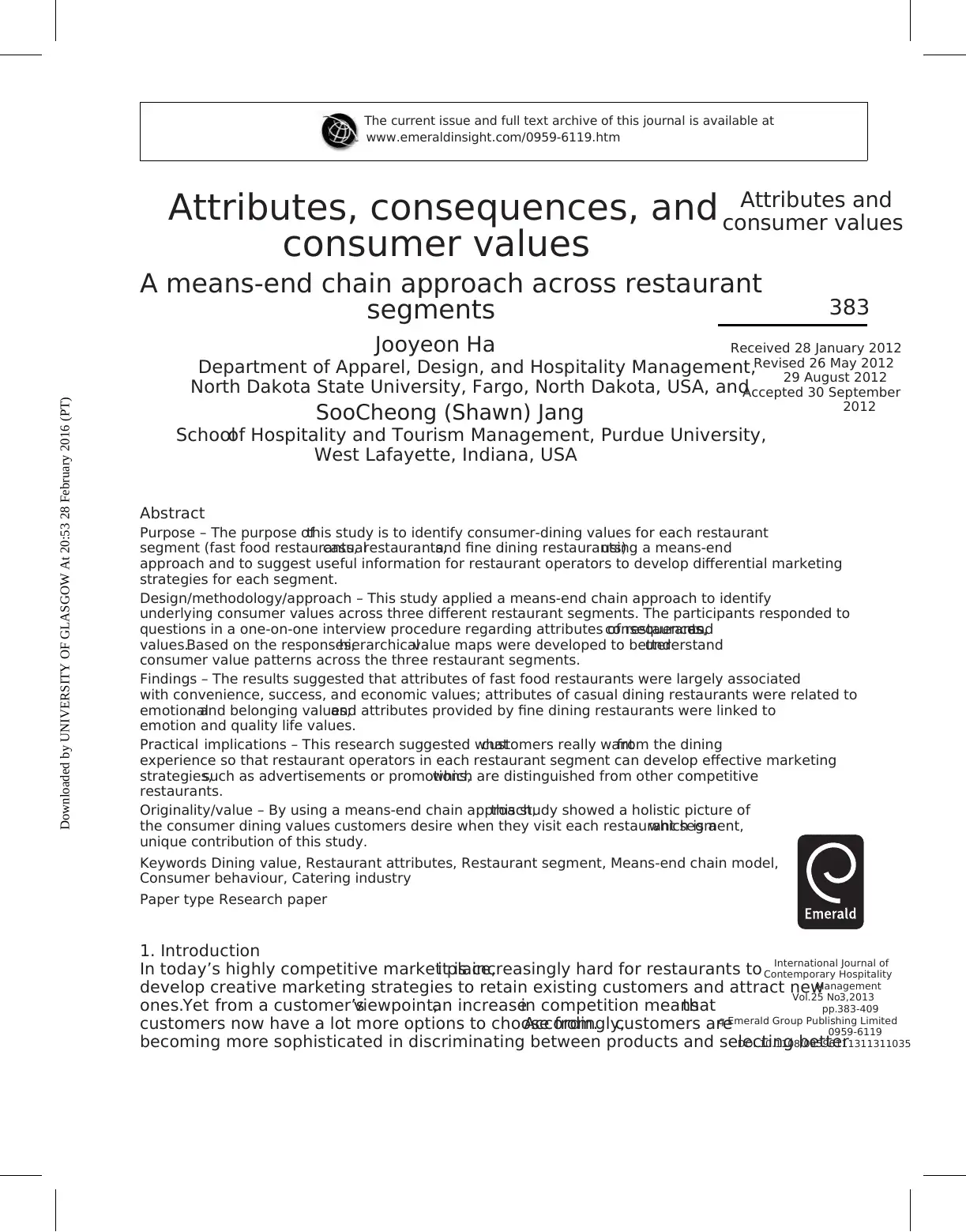
Attributes, consequences, and
consumer values
A means-end chain approach across restaurant
segments
Jooyeon Ha
Department of Apparel, Design, and Hospitality Management,
North Dakota State University, Fargo, North Dakota, USA, and
SooCheong (Shawn) Jang
Schoolof Hospitality and Tourism Management, Purdue University,
West Lafayette, Indiana, USA
Abstract
Purpose – The purpose ofthis study is to identify consumer-dining values for each restaurant
segment (fast food restaurants,casualrestaurants,and fine dining restaurants)using a means-end
approach and to suggest useful information for restaurant operators to develop differential marketing
strategies for each segment.
Design/methodology/approach – This study applied a means-end chain approach to identify
underlying consumer values across three different restaurant segments. The participants responded to
questions in a one-on-one interview procedure regarding attributes of restaurants,consequences,and
values.Based on the responses,hierarchicalvalue maps were developed to betterunderstand
consumer value patterns across the three restaurant segments.
Findings – The results suggested that attributes of fast food restaurants were largely associated
with convenience, success, and economic values; attributes of casual dining restaurants were related to
emotionaland belonging values;and attributes provided by fine dining restaurants were linked to
emotion and quality life values.
Practical implications – This research suggested whatcustomers really wantfrom the dining
experience so that restaurant operators in each restaurant segment can develop effective marketing
strategies,such as advertisements or promotions,which are distinguished from other competitive
restaurants.
Originality/value – By using a means-end chain approach,this study showed a holistic picture of
the consumer dining values customers desire when they visit each restaurant segment,which is a
unique contribution of this study.
Keywords Dining value, Restaurant attributes, Restaurant segment, Means-end chain model,
Consumer behaviour, Catering industry
Paper type Research paper
1. Introduction
In today’s highly competitive market place,it is increasingly hard for restaurants to
develop creative marketing strategies to retain existing customers and attract new
ones.Yet from a customer’sviewpoint,an increasein competition meansthat
customers now have a lot more options to choose from.Accordingly,customers are
becoming more sophisticated in discriminating between products and selecting better
The current issue and full text archive of this journal is available at
www.emeraldinsight.com/0959-6119.htm
Attributes and
consumer values
383
Received 28 January 2012
Revised 26 May 2012
29 August 2012
Accepted 30 September
2012
International Journal of
Contemporary Hospitality
Management
Vol.25 No.3,2013
pp.383-409
q Emerald Group Publishing Limited
0959-6119
DOI 10.1108/09596111311311035
Downloaded by UNIVERSITY OF GLASGOW At 20:53 28 February 2016 (PT)
consumer values
A means-end chain approach across restaurant
segments
Jooyeon Ha
Department of Apparel, Design, and Hospitality Management,
North Dakota State University, Fargo, North Dakota, USA, and
SooCheong (Shawn) Jang
Schoolof Hospitality and Tourism Management, Purdue University,
West Lafayette, Indiana, USA
Abstract
Purpose – The purpose ofthis study is to identify consumer-dining values for each restaurant
segment (fast food restaurants,casualrestaurants,and fine dining restaurants)using a means-end
approach and to suggest useful information for restaurant operators to develop differential marketing
strategies for each segment.
Design/methodology/approach – This study applied a means-end chain approach to identify
underlying consumer values across three different restaurant segments. The participants responded to
questions in a one-on-one interview procedure regarding attributes of restaurants,consequences,and
values.Based on the responses,hierarchicalvalue maps were developed to betterunderstand
consumer value patterns across the three restaurant segments.
Findings – The results suggested that attributes of fast food restaurants were largely associated
with convenience, success, and economic values; attributes of casual dining restaurants were related to
emotionaland belonging values;and attributes provided by fine dining restaurants were linked to
emotion and quality life values.
Practical implications – This research suggested whatcustomers really wantfrom the dining
experience so that restaurant operators in each restaurant segment can develop effective marketing
strategies,such as advertisements or promotions,which are distinguished from other competitive
restaurants.
Originality/value – By using a means-end chain approach,this study showed a holistic picture of
the consumer dining values customers desire when they visit each restaurant segment,which is a
unique contribution of this study.
Keywords Dining value, Restaurant attributes, Restaurant segment, Means-end chain model,
Consumer behaviour, Catering industry
Paper type Research paper
1. Introduction
In today’s highly competitive market place,it is increasingly hard for restaurants to
develop creative marketing strategies to retain existing customers and attract new
ones.Yet from a customer’sviewpoint,an increasein competition meansthat
customers now have a lot more options to choose from.Accordingly,customers are
becoming more sophisticated in discriminating between products and selecting better
The current issue and full text archive of this journal is available at
www.emeraldinsight.com/0959-6119.htm
Attributes and
consumer values
383
Received 28 January 2012
Revised 26 May 2012
29 August 2012
Accepted 30 September
2012
International Journal of
Contemporary Hospitality
Management
Vol.25 No.3,2013
pp.383-409
q Emerald Group Publishing Limited
0959-6119
DOI 10.1108/09596111311311035
Downloaded by UNIVERSITY OF GLASGOW At 20:53 28 February 2016 (PT)
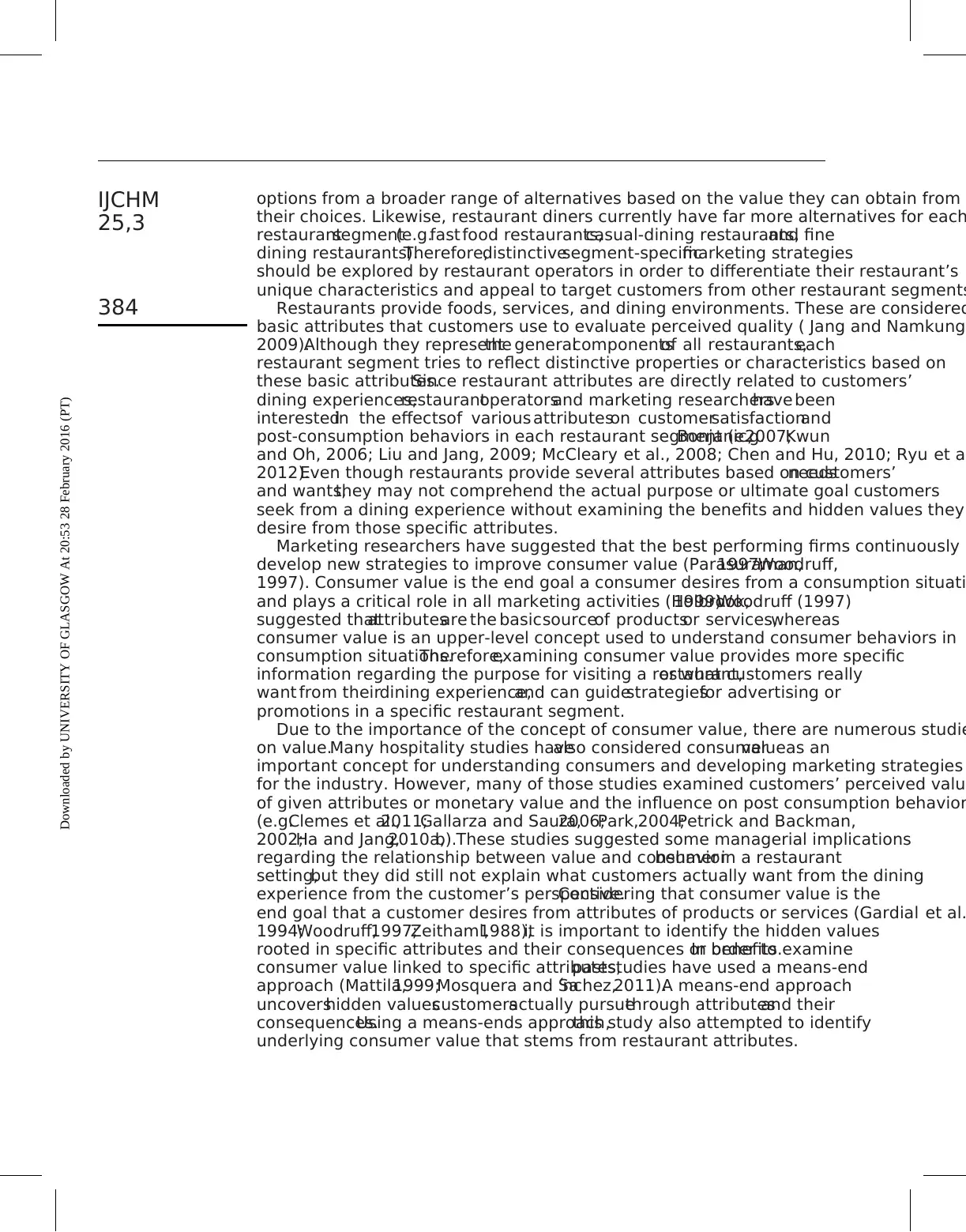
options from a broader range of alternatives based on the value they can obtain from
their choices. Likewise, restaurant diners currently have far more alternatives for each
restaurantsegment(e.g.fast food restaurants,casual-dining restaurants,and fine
dining restaurants).Therefore,distinctivesegment-specificmarketing strategies
should be explored by restaurant operators in order to differentiate their restaurant’s
unique characteristics and appeal to target customers from other restaurant segments
Restaurants provide foods, services, and dining environments. These are considered
basic attributes that customers use to evaluate perceived quality ( Jang and Namkung,
2009).Although they representthe generalcomponentsof all restaurants,each
restaurant segment tries to reflect distinctive properties or characteristics based on
these basic attributes.Since restaurant attributes are directly related to customers’
dining experiences,restaurantoperatorsand marketing researchershave been
interestedin the effectsof various attributeson customersatisfactionand
post-consumption behaviors in each restaurant segment (e.g.Bonjanic,2007;Kwun
and Oh, 2006; Liu and Jang, 2009; McCleary et al., 2008; Chen and Hu, 2010; Ryu et al
2012).Even though restaurants provide several attributes based on customers’needs
and wants,they may not comprehend the actual purpose or ultimate goal customers
seek from a dining experience without examining the benefits and hidden values they
desire from those specific attributes.
Marketing researchers have suggested that the best performing firms continuously
develop new strategies to improve consumer value (Parasuraman,1997;Woodruff,
1997). Consumer value is the end goal a consumer desires from a consumption situati
and plays a critical role in all marketing activities (Holbrook,1999).Woodruff (1997)
suggested thatattributesare the basicsourceof productsor services,whereas
consumer value is an upper-level concept used to understand consumer behaviors in
consumption situations.Therefore,examining consumer value provides more specific
information regarding the purpose for visiting a restaurant,or what customers really
want from theirdining experience,and can guidestrategiesfor advertising or
promotions in a specific restaurant segment.
Due to the importance of the concept of consumer value, there are numerous studie
on value.Many hospitality studies havealso considered consumervalueas an
important concept for understanding consumers and developing marketing strategies
for the industry. However, many of those studies examined customers’ perceived value
of given attributes or monetary value and the influence on post consumption behavior
(e.g.Clemes et al.,2011;Gallarza and Saura,2006;Park,2004;Petrick and Backman,
2002;Ha and Jang,2010a,b).These studies suggested some managerial implications
regarding the relationship between value and consumerbehaviorin a restaurant
setting,but they did still not explain what customers actually want from the dining
experience from the customer’s perspective.Considering that consumer value is the
end goal that a customer desires from attributes of products or services (Gardial et al.
1994;Woodruff,1997;Zeithaml,1988),it is important to identify the hidden values
rooted in specific attributes and their consequences or benefits.In order to examine
consumer value linked to specific attributes,paststudies have used a means-end
approach (Mattila,1999;Mosquera and Sa´nchez,2011).A means-end approach
uncovershidden valuescustomersactually pursuethrough attributesand their
consequences.Using a means-ends approach,this study also attempted to identify
underlying consumer value that stems from restaurant attributes.
IJCHM
25,3
384
Downloaded by UNIVERSITY OF GLASGOW At 20:53 28 February 2016 (PT)
their choices. Likewise, restaurant diners currently have far more alternatives for each
restaurantsegment(e.g.fast food restaurants,casual-dining restaurants,and fine
dining restaurants).Therefore,distinctivesegment-specificmarketing strategies
should be explored by restaurant operators in order to differentiate their restaurant’s
unique characteristics and appeal to target customers from other restaurant segments
Restaurants provide foods, services, and dining environments. These are considered
basic attributes that customers use to evaluate perceived quality ( Jang and Namkung,
2009).Although they representthe generalcomponentsof all restaurants,each
restaurant segment tries to reflect distinctive properties or characteristics based on
these basic attributes.Since restaurant attributes are directly related to customers’
dining experiences,restaurantoperatorsand marketing researchershave been
interestedin the effectsof various attributeson customersatisfactionand
post-consumption behaviors in each restaurant segment (e.g.Bonjanic,2007;Kwun
and Oh, 2006; Liu and Jang, 2009; McCleary et al., 2008; Chen and Hu, 2010; Ryu et al
2012).Even though restaurants provide several attributes based on customers’needs
and wants,they may not comprehend the actual purpose or ultimate goal customers
seek from a dining experience without examining the benefits and hidden values they
desire from those specific attributes.
Marketing researchers have suggested that the best performing firms continuously
develop new strategies to improve consumer value (Parasuraman,1997;Woodruff,
1997). Consumer value is the end goal a consumer desires from a consumption situati
and plays a critical role in all marketing activities (Holbrook,1999).Woodruff (1997)
suggested thatattributesare the basicsourceof productsor services,whereas
consumer value is an upper-level concept used to understand consumer behaviors in
consumption situations.Therefore,examining consumer value provides more specific
information regarding the purpose for visiting a restaurant,or what customers really
want from theirdining experience,and can guidestrategiesfor advertising or
promotions in a specific restaurant segment.
Due to the importance of the concept of consumer value, there are numerous studie
on value.Many hospitality studies havealso considered consumervalueas an
important concept for understanding consumers and developing marketing strategies
for the industry. However, many of those studies examined customers’ perceived value
of given attributes or monetary value and the influence on post consumption behavior
(e.g.Clemes et al.,2011;Gallarza and Saura,2006;Park,2004;Petrick and Backman,
2002;Ha and Jang,2010a,b).These studies suggested some managerial implications
regarding the relationship between value and consumerbehaviorin a restaurant
setting,but they did still not explain what customers actually want from the dining
experience from the customer’s perspective.Considering that consumer value is the
end goal that a customer desires from attributes of products or services (Gardial et al.
1994;Woodruff,1997;Zeithaml,1988),it is important to identify the hidden values
rooted in specific attributes and their consequences or benefits.In order to examine
consumer value linked to specific attributes,paststudies have used a means-end
approach (Mattila,1999;Mosquera and Sa´nchez,2011).A means-end approach
uncovershidden valuescustomersactually pursuethrough attributesand their
consequences.Using a means-ends approach,this study also attempted to identify
underlying consumer value that stems from restaurant attributes.
IJCHM
25,3
384
Downloaded by UNIVERSITY OF GLASGOW At 20:53 28 February 2016 (PT)
⊘ This is a preview!⊘
Do you want full access?
Subscribe today to unlock all pages.

Trusted by 1+ million students worldwide
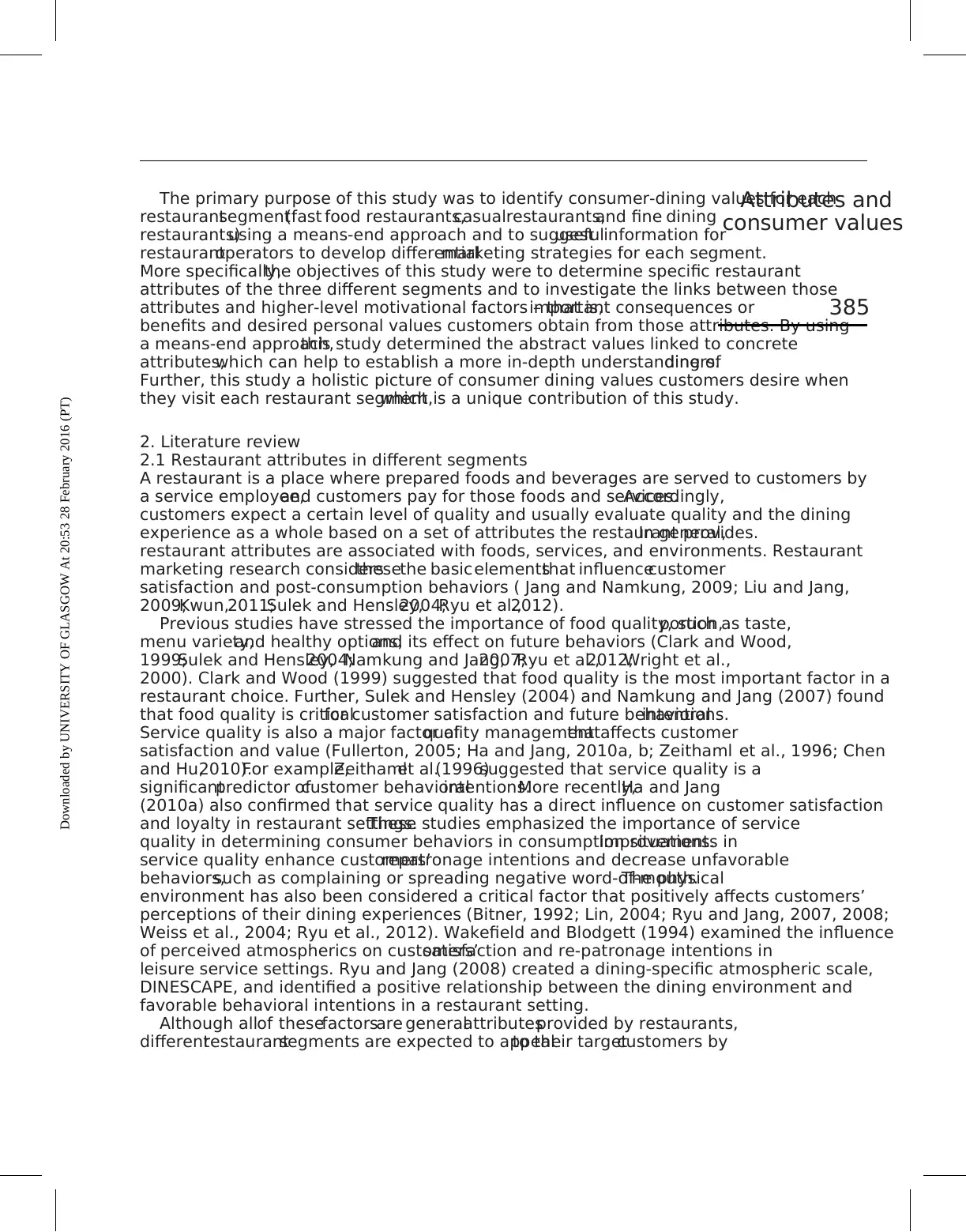
The primary purpose of this study was to identify consumer-dining values for each
restaurantsegment(fast food restaurants,casualrestaurants,and fine dining
restaurants)using a means-end approach and to suggestusefulinformation for
restaurantoperators to develop differentialmarketing strategies for each segment.
More specifically,the objectives of this study were to determine specific restaurant
attributes of the three different segments and to investigate the links between those
attributes and higher-level motivational factors – that is,important consequences or
benefits and desired personal values customers obtain from those attributes. By using
a means-end approach,this study determined the abstract values linked to concrete
attributes,which can help to establish a more in-depth understanding ofdiners.
Further, this study a holistic picture of consumer dining values customers desire when
they visit each restaurant segment,which is a unique contribution of this study.
2. Literature review
2.1 Restaurant attributes in different segments
A restaurant is a place where prepared foods and beverages are served to customers by
a service employee,and customers pay for those foods and services.Accordingly,
customers expect a certain level of quality and usually evaluate quality and the dining
experience as a whole based on a set of attributes the restaurant provides.In general,
restaurant attributes are associated with foods, services, and environments. Restaurant
marketing research considersthesethe basicelementsthat influencecustomer
satisfaction and post-consumption behaviors ( Jang and Namkung, 2009; Liu and Jang,
2009;Kwun,2011;Sulek and Hensley,2004;Ryu et al.,2012).
Previous studies have stressed the importance of food quality, such as taste,portion,
menu variety,and healthy options,and its effect on future behaviors (Clark and Wood,
1999;Sulek and Hensley,2004;Namkung and Jang,2007;Ryu et al.,2012;Wright et al.,
2000). Clark and Wood (1999) suggested that food quality is the most important factor in a
restaurant choice. Further, Sulek and Hensley (2004) and Namkung and Jang (2007) found
that food quality is criticalfor customer satisfaction and future behavioralintentions.
Service quality is also a major factor ofquality managementthataffects customer
satisfaction and value (Fullerton, 2005; Ha and Jang, 2010a, b; Zeithaml et al., 1996; Chen
and Hu,2010).For example,Zeithamlet al.(1996)suggested that service quality is a
significantpredictor ofcustomer behavioralintentions.More recently,Ha and Jang
(2010a) also confirmed that service quality has a direct influence on customer satisfaction
and loyalty in restaurant settings.These studies emphasized the importance of service
quality in determining consumer behaviors in consumption situations.Improvements in
service quality enhance customers’repatronage intentions and decrease unfavorable
behaviors,such as complaining or spreading negative word-of-mouth.The physical
environment has also been considered a critical factor that positively affects customers’
perceptions of their dining experiences (Bitner, 1992; Lin, 2004; Ryu and Jang, 2007, 2008;
Weiss et al., 2004; Ryu et al., 2012). Wakefield and Blodgett (1994) examined the influence
of perceived atmospherics on customers’satisfaction and re-patronage intentions in
leisure service settings. Ryu and Jang (2008) created a dining-specific atmospheric scale,
DINESCAPE, and identified a positive relationship between the dining environment and
favorable behavioral intentions in a restaurant setting.
Although allof thesefactorsare generalattributesprovided by restaurants,
differentrestaurantsegments are expected to appealto their targetcustomers by
Attributes and
consumer values
385
Downloaded by UNIVERSITY OF GLASGOW At 20:53 28 February 2016 (PT)
restaurantsegment(fast food restaurants,casualrestaurants,and fine dining
restaurants)using a means-end approach and to suggestusefulinformation for
restaurantoperators to develop differentialmarketing strategies for each segment.
More specifically,the objectives of this study were to determine specific restaurant
attributes of the three different segments and to investigate the links between those
attributes and higher-level motivational factors – that is,important consequences or
benefits and desired personal values customers obtain from those attributes. By using
a means-end approach,this study determined the abstract values linked to concrete
attributes,which can help to establish a more in-depth understanding ofdiners.
Further, this study a holistic picture of consumer dining values customers desire when
they visit each restaurant segment,which is a unique contribution of this study.
2. Literature review
2.1 Restaurant attributes in different segments
A restaurant is a place where prepared foods and beverages are served to customers by
a service employee,and customers pay for those foods and services.Accordingly,
customers expect a certain level of quality and usually evaluate quality and the dining
experience as a whole based on a set of attributes the restaurant provides.In general,
restaurant attributes are associated with foods, services, and environments. Restaurant
marketing research considersthesethe basicelementsthat influencecustomer
satisfaction and post-consumption behaviors ( Jang and Namkung, 2009; Liu and Jang,
2009;Kwun,2011;Sulek and Hensley,2004;Ryu et al.,2012).
Previous studies have stressed the importance of food quality, such as taste,portion,
menu variety,and healthy options,and its effect on future behaviors (Clark and Wood,
1999;Sulek and Hensley,2004;Namkung and Jang,2007;Ryu et al.,2012;Wright et al.,
2000). Clark and Wood (1999) suggested that food quality is the most important factor in a
restaurant choice. Further, Sulek and Hensley (2004) and Namkung and Jang (2007) found
that food quality is criticalfor customer satisfaction and future behavioralintentions.
Service quality is also a major factor ofquality managementthataffects customer
satisfaction and value (Fullerton, 2005; Ha and Jang, 2010a, b; Zeithaml et al., 1996; Chen
and Hu,2010).For example,Zeithamlet al.(1996)suggested that service quality is a
significantpredictor ofcustomer behavioralintentions.More recently,Ha and Jang
(2010a) also confirmed that service quality has a direct influence on customer satisfaction
and loyalty in restaurant settings.These studies emphasized the importance of service
quality in determining consumer behaviors in consumption situations.Improvements in
service quality enhance customers’repatronage intentions and decrease unfavorable
behaviors,such as complaining or spreading negative word-of-mouth.The physical
environment has also been considered a critical factor that positively affects customers’
perceptions of their dining experiences (Bitner, 1992; Lin, 2004; Ryu and Jang, 2007, 2008;
Weiss et al., 2004; Ryu et al., 2012). Wakefield and Blodgett (1994) examined the influence
of perceived atmospherics on customers’satisfaction and re-patronage intentions in
leisure service settings. Ryu and Jang (2008) created a dining-specific atmospheric scale,
DINESCAPE, and identified a positive relationship between the dining environment and
favorable behavioral intentions in a restaurant setting.
Although allof thesefactorsare generalattributesprovided by restaurants,
differentrestaurantsegments are expected to appealto their targetcustomers by
Attributes and
consumer values
385
Downloaded by UNIVERSITY OF GLASGOW At 20:53 28 February 2016 (PT)
Paraphrase This Document
Need a fresh take? Get an instant paraphrase of this document with our AI Paraphraser
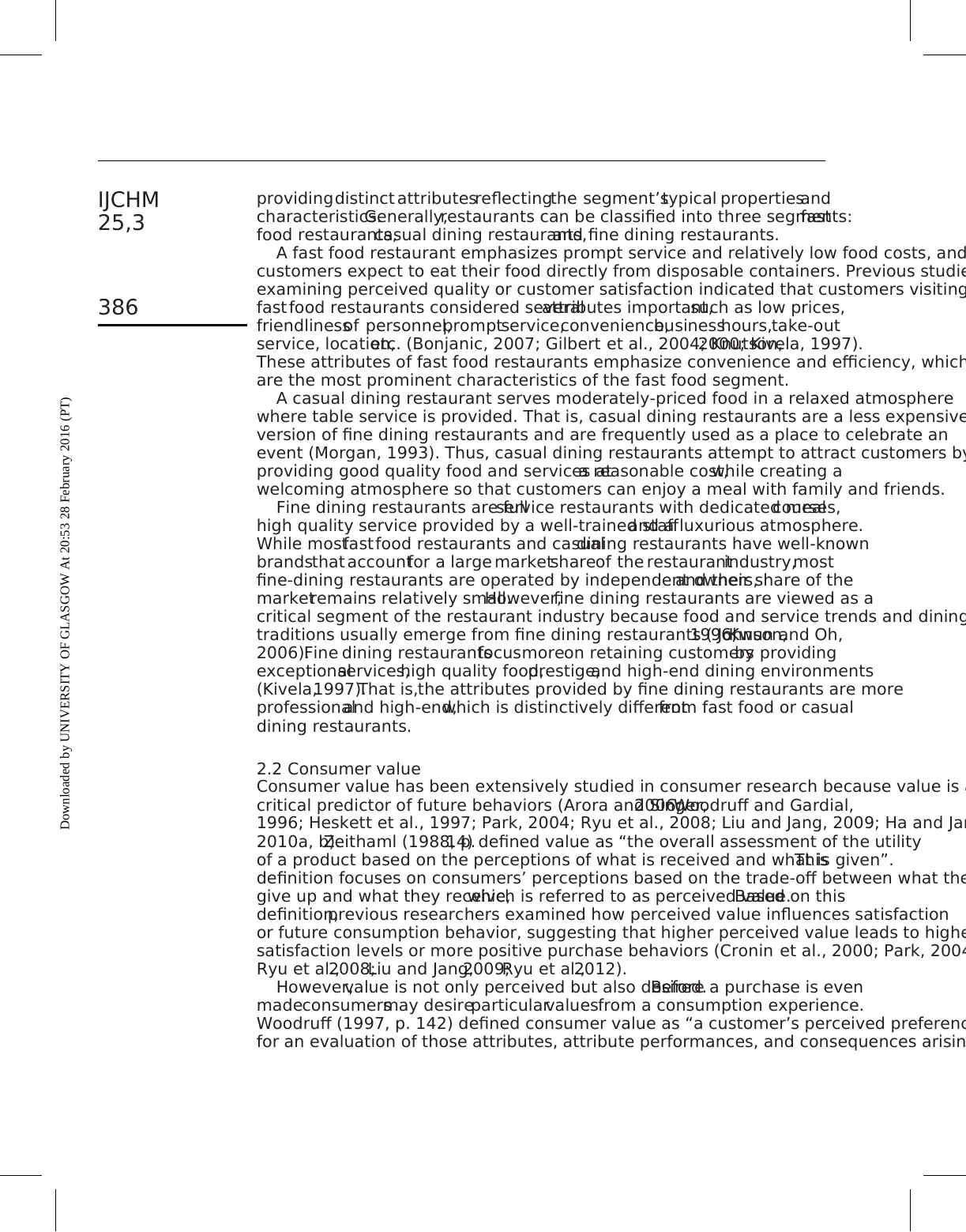
providingdistinct attributesreflectingthe segment’stypical propertiesand
characteristics.Generally,restaurants can be classified into three segments:fast
food restaurants,casual dining restaurants,and fine dining restaurants.
A fast food restaurant emphasizes prompt service and relatively low food costs, and
customers expect to eat their food directly from disposable containers. Previous studie
examining perceived quality or customer satisfaction indicated that customers visiting
fast food restaurants considered severalattributes important,such as low prices,
friendlinessof personnel,promptservice,convenience,businesshours,take-out
service, location,etc. (Bonjanic, 2007; Gilbert et al., 2004; Knutson,2000; Kivela, 1997).
These attributes of fast food restaurants emphasize convenience and efficiency, which
are the most prominent characteristics of the fast food segment.
A casual dining restaurant serves moderately-priced food in a relaxed atmosphere
where table service is provided. That is, casual dining restaurants are a less expensive
version of fine dining restaurants and are frequently used as a place to celebrate an
event (Morgan, 1993). Thus, casual dining restaurants attempt to attract customers by
providing good quality food and services ata reasonable cost,while creating a
welcoming atmosphere so that customers can enjoy a meal with family and friends.
Fine dining restaurants are fullservice restaurants with dedicated mealcourses,
high quality service provided by a well-trained staffand a luxurious atmosphere.
While mostfast food restaurants and casualdining restaurants have well-known
brandsthat accountfor a large marketshareof the restaurantindustry,most
fine-dining restaurants are operated by independent owners,and their share of the
marketremains relatively small.However,fine dining restaurants are viewed as a
critical segment of the restaurant industry because food and service trends and dining
traditions usually emerge from fine dining restaurants ( Johnson,1996;Kwun and Oh,
2006).Fine dining restaurantsfocusmoreon retaining customersby providing
exceptionalservices,high quality food,prestige,and high-end dining environments
(Kivela,1997).That is,the attributes provided by fine dining restaurants are more
professionaland high-end,which is distinctively differentfrom fast food or casual
dining restaurants.
2.2 Consumer value
Consumer value has been extensively studied in consumer research because value is a
critical predictor of future behaviors (Arora and Singer,2006;Woodruff and Gardial,
1996; Heskett et al., 1997; Park, 2004; Ryu et al., 2008; Liu and Jang, 2009; Ha and Jan
2010a, b).Zeithaml (1988, p.14) defined value as “the overall assessment of the utility
of a product based on the perceptions of what is received and what is given”.This
definition focuses on consumers’ perceptions based on the trade-off between what the
give up and what they receive,which is referred to as perceived value.Based on this
definition,previous researchers examined how perceived value influences satisfaction
or future consumption behavior, suggesting that higher perceived value leads to highe
satisfaction levels or more positive purchase behaviors (Cronin et al., 2000; Park, 2004
Ryu et al.,2008;Liu and Jang,2009;Ryu et al.,2012).
However,value is not only perceived but also desired.Before a purchase is even
madeconsumersmay desireparticularvaluesfrom a consumption experience.
Woodruff (1997, p. 142) defined consumer value as “a customer’s perceived preferenc
for an evaluation of those attributes, attribute performances, and consequences arisin
IJCHM
25,3
386
Downloaded by UNIVERSITY OF GLASGOW At 20:53 28 February 2016 (PT)
characteristics.Generally,restaurants can be classified into three segments:fast
food restaurants,casual dining restaurants,and fine dining restaurants.
A fast food restaurant emphasizes prompt service and relatively low food costs, and
customers expect to eat their food directly from disposable containers. Previous studie
examining perceived quality or customer satisfaction indicated that customers visiting
fast food restaurants considered severalattributes important,such as low prices,
friendlinessof personnel,promptservice,convenience,businesshours,take-out
service, location,etc. (Bonjanic, 2007; Gilbert et al., 2004; Knutson,2000; Kivela, 1997).
These attributes of fast food restaurants emphasize convenience and efficiency, which
are the most prominent characteristics of the fast food segment.
A casual dining restaurant serves moderately-priced food in a relaxed atmosphere
where table service is provided. That is, casual dining restaurants are a less expensive
version of fine dining restaurants and are frequently used as a place to celebrate an
event (Morgan, 1993). Thus, casual dining restaurants attempt to attract customers by
providing good quality food and services ata reasonable cost,while creating a
welcoming atmosphere so that customers can enjoy a meal with family and friends.
Fine dining restaurants are fullservice restaurants with dedicated mealcourses,
high quality service provided by a well-trained staffand a luxurious atmosphere.
While mostfast food restaurants and casualdining restaurants have well-known
brandsthat accountfor a large marketshareof the restaurantindustry,most
fine-dining restaurants are operated by independent owners,and their share of the
marketremains relatively small.However,fine dining restaurants are viewed as a
critical segment of the restaurant industry because food and service trends and dining
traditions usually emerge from fine dining restaurants ( Johnson,1996;Kwun and Oh,
2006).Fine dining restaurantsfocusmoreon retaining customersby providing
exceptionalservices,high quality food,prestige,and high-end dining environments
(Kivela,1997).That is,the attributes provided by fine dining restaurants are more
professionaland high-end,which is distinctively differentfrom fast food or casual
dining restaurants.
2.2 Consumer value
Consumer value has been extensively studied in consumer research because value is a
critical predictor of future behaviors (Arora and Singer,2006;Woodruff and Gardial,
1996; Heskett et al., 1997; Park, 2004; Ryu et al., 2008; Liu and Jang, 2009; Ha and Jan
2010a, b).Zeithaml (1988, p.14) defined value as “the overall assessment of the utility
of a product based on the perceptions of what is received and what is given”.This
definition focuses on consumers’ perceptions based on the trade-off between what the
give up and what they receive,which is referred to as perceived value.Based on this
definition,previous researchers examined how perceived value influences satisfaction
or future consumption behavior, suggesting that higher perceived value leads to highe
satisfaction levels or more positive purchase behaviors (Cronin et al., 2000; Park, 2004
Ryu et al.,2008;Liu and Jang,2009;Ryu et al.,2012).
However,value is not only perceived but also desired.Before a purchase is even
madeconsumersmay desireparticularvaluesfrom a consumption experience.
Woodruff (1997, p. 142) defined consumer value as “a customer’s perceived preferenc
for an evaluation of those attributes, attribute performances, and consequences arisin
IJCHM
25,3
386
Downloaded by UNIVERSITY OF GLASGOW At 20:53 28 February 2016 (PT)
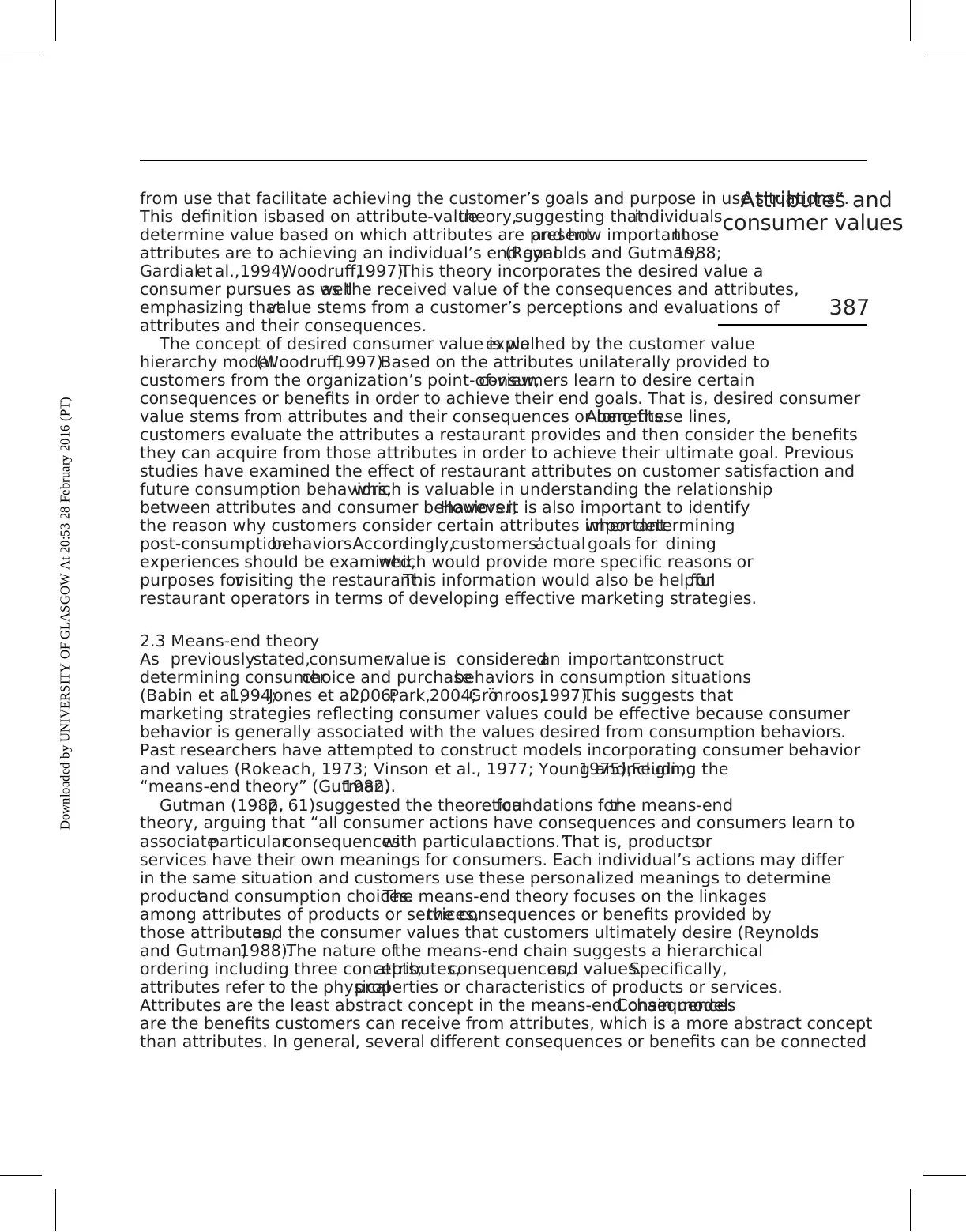
from use that facilitate achieving the customer’s goals and purpose in use situations”.
This definition isbased on attribute-valuetheory,suggesting thatindividuals
determine value based on which attributes are presentand how importantthose
attributes are to achieving an individual’s end goal(Reynolds and Gutman,1988;
Gardialet al.,1994;Woodruff,1997).This theory incorporates the desired value a
consumer pursues as wellas the received value of the consequences and attributes,
emphasizing thatvalue stems from a customer’s perceptions and evaluations of
attributes and their consequences.
The concept of desired consumer value is wellexplained by the customer value
hierarchy model(Woodruff,1997).Based on the attributes unilaterally provided to
customers from the organization’s point-of-view,consumers learn to desire certain
consequences or benefits in order to achieve their end goals. That is, desired consumer
value stems from attributes and their consequences or benefits.Along these lines,
customers evaluate the attributes a restaurant provides and then consider the benefits
they can acquire from those attributes in order to achieve their ultimate goal. Previous
studies have examined the effect of restaurant attributes on customer satisfaction and
future consumption behaviors,which is valuable in understanding the relationship
between attributes and consumer behaviors.However,it is also important to identify
the reason why customers consider certain attributes importantwhen determining
post-consumptionbehaviors.Accordingly,customers’actual goals for dining
experiences should be examined,which would provide more specific reasons or
purposes forvisiting the restaurant.This information would also be helpfulfor
restaurant operators in terms of developing effective marketing strategies.
2.3 Means-end theory
As previouslystated,consumervalue is consideredan importantconstruct
determining consumerchoice and purchasebehaviors in consumption situations
(Babin et al.,1994;Jones et al.,2006;Park,2004;Gro¨nroos,1997).This suggests that
marketing strategies reflecting consumer values could be effective because consumer
behavior is generally associated with the values desired from consumption behaviors.
Past researchers have attempted to construct models incorporating consumer behavior
and values (Rokeach, 1973; Vinson et al., 1977; Young and Feigin,1975),including the
“means-end theory” (Gutman,1982).
Gutman (1982,p. 61)suggested the theoreticalfoundations forthe means-end
theory, arguing that “all consumer actions have consequences and consumers learn to
associateparticularconsequenceswith particularactions.”That is, productsor
services have their own meanings for consumers. Each individual’s actions may differ
in the same situation and customers use these personalized meanings to determine
productand consumption choices.The means-end theory focuses on the linkages
among attributes of products or services,the consequences or benefits provided by
those attributes,and the consumer values that customers ultimately desire (Reynolds
and Gutman,1988).The nature ofthe means-end chain suggests a hierarchical
ordering including three concepts;attributes,consequences,and values.Specifically,
attributes refer to the physicalproperties or characteristics of products or services.
Attributes are the least abstract concept in the means-end chain model.Consequences
are the benefits customers can receive from attributes, which is a more abstract concept
than attributes. In general, several different consequences or benefits can be connected
Attributes and
consumer values
387
Downloaded by UNIVERSITY OF GLASGOW At 20:53 28 February 2016 (PT)
This definition isbased on attribute-valuetheory,suggesting thatindividuals
determine value based on which attributes are presentand how importantthose
attributes are to achieving an individual’s end goal(Reynolds and Gutman,1988;
Gardialet al.,1994;Woodruff,1997).This theory incorporates the desired value a
consumer pursues as wellas the received value of the consequences and attributes,
emphasizing thatvalue stems from a customer’s perceptions and evaluations of
attributes and their consequences.
The concept of desired consumer value is wellexplained by the customer value
hierarchy model(Woodruff,1997).Based on the attributes unilaterally provided to
customers from the organization’s point-of-view,consumers learn to desire certain
consequences or benefits in order to achieve their end goals. That is, desired consumer
value stems from attributes and their consequences or benefits.Along these lines,
customers evaluate the attributes a restaurant provides and then consider the benefits
they can acquire from those attributes in order to achieve their ultimate goal. Previous
studies have examined the effect of restaurant attributes on customer satisfaction and
future consumption behaviors,which is valuable in understanding the relationship
between attributes and consumer behaviors.However,it is also important to identify
the reason why customers consider certain attributes importantwhen determining
post-consumptionbehaviors.Accordingly,customers’actual goals for dining
experiences should be examined,which would provide more specific reasons or
purposes forvisiting the restaurant.This information would also be helpfulfor
restaurant operators in terms of developing effective marketing strategies.
2.3 Means-end theory
As previouslystated,consumervalue is consideredan importantconstruct
determining consumerchoice and purchasebehaviors in consumption situations
(Babin et al.,1994;Jones et al.,2006;Park,2004;Gro¨nroos,1997).This suggests that
marketing strategies reflecting consumer values could be effective because consumer
behavior is generally associated with the values desired from consumption behaviors.
Past researchers have attempted to construct models incorporating consumer behavior
and values (Rokeach, 1973; Vinson et al., 1977; Young and Feigin,1975),including the
“means-end theory” (Gutman,1982).
Gutman (1982,p. 61)suggested the theoreticalfoundations forthe means-end
theory, arguing that “all consumer actions have consequences and consumers learn to
associateparticularconsequenceswith particularactions.”That is, productsor
services have their own meanings for consumers. Each individual’s actions may differ
in the same situation and customers use these personalized meanings to determine
productand consumption choices.The means-end theory focuses on the linkages
among attributes of products or services,the consequences or benefits provided by
those attributes,and the consumer values that customers ultimately desire (Reynolds
and Gutman,1988).The nature ofthe means-end chain suggests a hierarchical
ordering including three concepts;attributes,consequences,and values.Specifically,
attributes refer to the physicalproperties or characteristics of products or services.
Attributes are the least abstract concept in the means-end chain model.Consequences
are the benefits customers can receive from attributes, which is a more abstract concept
than attributes. In general, several different consequences or benefits can be connected
Attributes and
consumer values
387
Downloaded by UNIVERSITY OF GLASGOW At 20:53 28 February 2016 (PT)
⊘ This is a preview!⊘
Do you want full access?
Subscribe today to unlock all pages.

Trusted by 1+ million students worldwide
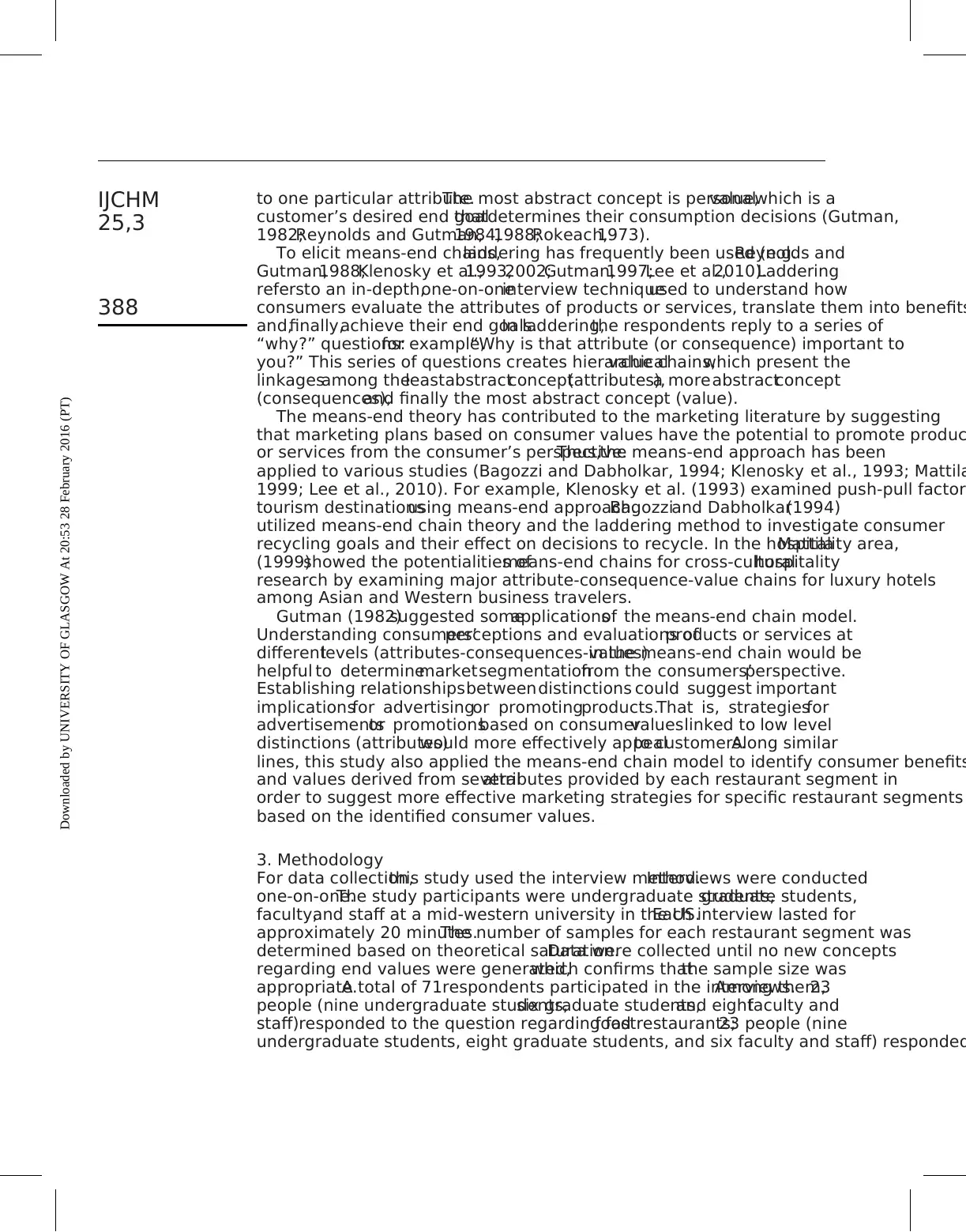
to one particular attribute.The most abstract concept is personalvalue,which is a
customer’s desired end goalthatdetermines their consumption decisions (Gutman,
1982;Reynolds and Gutman,1984,1988;Rokeach,1973).
To elicit means-end chains,laddering has frequently been used (e.g.Reynolds and
Gutman,1988;Klenosky et al.,1993,2002;Gutman,1997;Lee et al.,2010).Laddering
refersto an in-depth,one-on-oneinterview techniqueused to understand how
consumers evaluate the attributes of products or services, translate them into benefits
and,finally,achieve their end goals.In laddering,the respondents reply to a series of
“why?” questions:for example,“Why is that attribute (or consequence) important to
you?” This series of questions creates hierarchicalvalue chains,which present the
linkagesamong theleastabstractconcept(attributes),a moreabstractconcept
(consequences),and finally the most abstract concept (value).
The means-end theory has contributed to the marketing literature by suggesting
that marketing plans based on consumer values have the potential to promote produc
or services from the consumer’s perspective.Thus,the means-end approach has been
applied to various studies (Bagozzi and Dabholkar, 1994; Klenosky et al., 1993; Mattila
1999; Lee et al., 2010). For example, Klenosky et al. (1993) examined push-pull factors
tourism destinationsusing means-end approach.Bagozziand Dabholkar(1994)
utilized means-end chain theory and the laddering method to investigate consumer
recycling goals and their effect on decisions to recycle. In the hospitality area,Mattila
(1999)showed the potentialities ofmeans-end chains for cross-culturalhospitality
research by examining major attribute-consequence-value chains for luxury hotels
among Asian and Western business travelers.
Gutman (1982)suggested someapplicationsof the means-end chain model.
Understanding consumers’perceptions and evaluations ofproducts or services at
differentlevels (attributes-consequences-values)in the means-end chain would be
helpful to determinemarketsegmentationfrom the consumers’perspective.
Establishing relationshipsbetweendistinctions could suggest important
implicationsfor advertisingor promotingproducts.That is, strategiesfor
advertisementsor promotionsbased on consumervalueslinked to low level
distinctions (attributes)would more effectively appealto customers.Along similar
lines, this study also applied the means-end chain model to identify consumer benefits
and values derived from severalattributes provided by each restaurant segment in
order to suggest more effective marketing strategies for specific restaurant segments
based on the identified consumer values.
3. Methodology
For data collection,this study used the interview method.Interviews were conducted
one-on-one.The study participants were undergraduate students,graduate students,
faculty,and staff at a mid-western university in the US.Each interview lasted for
approximately 20 minutes.The number of samples for each restaurant segment was
determined based on theoretical saturation.Data were collected until no new concepts
regarding end values were generated,which confirms thatthe sample size was
appropriate.A total of 71respondents participated in the interviews.Among them,23
people (nine undergraduate students,six graduate students,and eightfaculty and
staff)responded to the question regarding fastfood restaurants;23 people (nine
undergraduate students, eight graduate students, and six faculty and staff) responded
IJCHM
25,3
388
Downloaded by UNIVERSITY OF GLASGOW At 20:53 28 February 2016 (PT)
customer’s desired end goalthatdetermines their consumption decisions (Gutman,
1982;Reynolds and Gutman,1984,1988;Rokeach,1973).
To elicit means-end chains,laddering has frequently been used (e.g.Reynolds and
Gutman,1988;Klenosky et al.,1993,2002;Gutman,1997;Lee et al.,2010).Laddering
refersto an in-depth,one-on-oneinterview techniqueused to understand how
consumers evaluate the attributes of products or services, translate them into benefits
and,finally,achieve their end goals.In laddering,the respondents reply to a series of
“why?” questions:for example,“Why is that attribute (or consequence) important to
you?” This series of questions creates hierarchicalvalue chains,which present the
linkagesamong theleastabstractconcept(attributes),a moreabstractconcept
(consequences),and finally the most abstract concept (value).
The means-end theory has contributed to the marketing literature by suggesting
that marketing plans based on consumer values have the potential to promote produc
or services from the consumer’s perspective.Thus,the means-end approach has been
applied to various studies (Bagozzi and Dabholkar, 1994; Klenosky et al., 1993; Mattila
1999; Lee et al., 2010). For example, Klenosky et al. (1993) examined push-pull factors
tourism destinationsusing means-end approach.Bagozziand Dabholkar(1994)
utilized means-end chain theory and the laddering method to investigate consumer
recycling goals and their effect on decisions to recycle. In the hospitality area,Mattila
(1999)showed the potentialities ofmeans-end chains for cross-culturalhospitality
research by examining major attribute-consequence-value chains for luxury hotels
among Asian and Western business travelers.
Gutman (1982)suggested someapplicationsof the means-end chain model.
Understanding consumers’perceptions and evaluations ofproducts or services at
differentlevels (attributes-consequences-values)in the means-end chain would be
helpful to determinemarketsegmentationfrom the consumers’perspective.
Establishing relationshipsbetweendistinctions could suggest important
implicationsfor advertisingor promotingproducts.That is, strategiesfor
advertisementsor promotionsbased on consumervalueslinked to low level
distinctions (attributes)would more effectively appealto customers.Along similar
lines, this study also applied the means-end chain model to identify consumer benefits
and values derived from severalattributes provided by each restaurant segment in
order to suggest more effective marketing strategies for specific restaurant segments
based on the identified consumer values.
3. Methodology
For data collection,this study used the interview method.Interviews were conducted
one-on-one.The study participants were undergraduate students,graduate students,
faculty,and staff at a mid-western university in the US.Each interview lasted for
approximately 20 minutes.The number of samples for each restaurant segment was
determined based on theoretical saturation.Data were collected until no new concepts
regarding end values were generated,which confirms thatthe sample size was
appropriate.A total of 71respondents participated in the interviews.Among them,23
people (nine undergraduate students,six graduate students,and eightfaculty and
staff)responded to the question regarding fastfood restaurants;23 people (nine
undergraduate students, eight graduate students, and six faculty and staff) responded
IJCHM
25,3
388
Downloaded by UNIVERSITY OF GLASGOW At 20:53 28 February 2016 (PT)
Paraphrase This Document
Need a fresh take? Get an instant paraphrase of this document with our AI Paraphraser
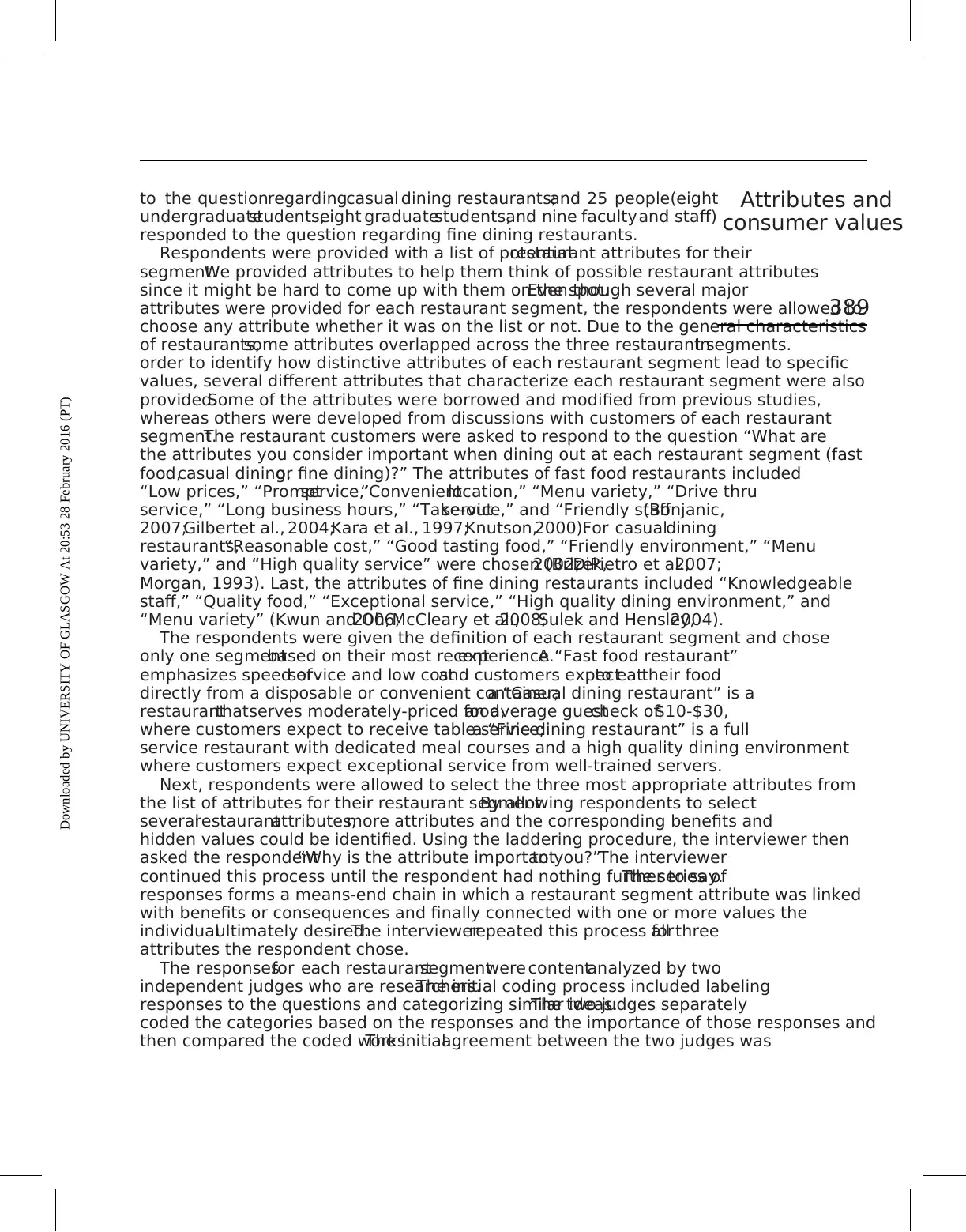
to the questionregardingcasual dining restaurants;and 25 people(eight
undergraduatestudents,eight graduatestudents,and nine facultyand staff)
responded to the question regarding fine dining restaurants.
Respondents were provided with a list of potentialrestaurant attributes for their
segment.We provided attributes to help them think of possible restaurant attributes
since it might be hard to come up with them on the spot.Even though several major
attributes were provided for each restaurant segment, the respondents were allowed to
choose any attribute whether it was on the list or not. Due to the general characteristics
of restaurants,some attributes overlapped across the three restaurant segments.In
order to identify how distinctive attributes of each restaurant segment lead to specific
values, several different attributes that characterize each restaurant segment were also
provided.Some of the attributes were borrowed and modified from previous studies,
whereas others were developed from discussions with customers of each restaurant
segment.The restaurant customers were asked to respond to the question “What are
the attributes you consider important when dining out at each restaurant segment (fast
food,casual dining,or fine dining)?” The attributes of fast food restaurants included
“Low prices,” “Promptservice,’“Convenientlocation,” “Menu variety,” “Drive thru
service,” “Long business hours,” “Take-outservice,” and “Friendly staff(Bonjanic,
2007;Gilbertet al., 2004;Kara et al., 1997;Knutson,2000).For casualdining
restaurants,“Reasonable cost,” “Good tasting food,” “Friendly environment,” “Menu
variety,” and “High quality service” were chosen (Brizek,2002;DiPietro et al.,2007;
Morgan, 1993). Last, the attributes of fine dining restaurants included “Knowledgeable
staff,” “Quality food,” “Exceptional service,” “High quality dining environment,” and
“Menu variety” (Kwun and Oh,2006;McCleary et al.,2008;Sulek and Hensley,2004).
The respondents were given the definition of each restaurant segment and chose
only one segmentbased on their most recentexperience.A “Fast food restaurant”
emphasizes speed ofservice and low costand customers expectto eattheir food
directly from a disposable or convenient container;a “Casual dining restaurant” is a
restaurantthatserves moderately-priced food,an average guestcheck of$10-$30,
where customers expect to receive table service;a “Fine dining restaurant” is a full
service restaurant with dedicated meal courses and a high quality dining environment
where customers expect exceptional service from well-trained servers.
Next, respondents were allowed to select the three most appropriate attributes from
the list of attributes for their restaurant segment.By allowing respondents to select
severalrestaurantattributes,more attributes and the corresponding benefits and
hidden values could be identified. Using the laddering procedure, the interviewer then
asked the respondent“Why is the attribute importantto you?”The interviewer
continued this process until the respondent had nothing further to say.The series of
responses forms a means-end chain in which a restaurant segment attribute was linked
with benefits or consequences and finally connected with one or more values the
individualultimately desired.The interviewerrepeated this process forall three
attributes the respondent chose.
The responsesfor each restaurantsegmentwere contentanalyzed by two
independent judges who are researchers.The initial coding process included labeling
responses to the questions and categorizing similar ideas.The two judges separately
coded the categories based on the responses and the importance of those responses and
then compared the coded works.The initialagreement between the two judges was
Attributes and
consumer values
389
Downloaded by UNIVERSITY OF GLASGOW At 20:53 28 February 2016 (PT)
undergraduatestudents,eight graduatestudents,and nine facultyand staff)
responded to the question regarding fine dining restaurants.
Respondents were provided with a list of potentialrestaurant attributes for their
segment.We provided attributes to help them think of possible restaurant attributes
since it might be hard to come up with them on the spot.Even though several major
attributes were provided for each restaurant segment, the respondents were allowed to
choose any attribute whether it was on the list or not. Due to the general characteristics
of restaurants,some attributes overlapped across the three restaurant segments.In
order to identify how distinctive attributes of each restaurant segment lead to specific
values, several different attributes that characterize each restaurant segment were also
provided.Some of the attributes were borrowed and modified from previous studies,
whereas others were developed from discussions with customers of each restaurant
segment.The restaurant customers were asked to respond to the question “What are
the attributes you consider important when dining out at each restaurant segment (fast
food,casual dining,or fine dining)?” The attributes of fast food restaurants included
“Low prices,” “Promptservice,’“Convenientlocation,” “Menu variety,” “Drive thru
service,” “Long business hours,” “Take-outservice,” and “Friendly staff(Bonjanic,
2007;Gilbertet al., 2004;Kara et al., 1997;Knutson,2000).For casualdining
restaurants,“Reasonable cost,” “Good tasting food,” “Friendly environment,” “Menu
variety,” and “High quality service” were chosen (Brizek,2002;DiPietro et al.,2007;
Morgan, 1993). Last, the attributes of fine dining restaurants included “Knowledgeable
staff,” “Quality food,” “Exceptional service,” “High quality dining environment,” and
“Menu variety” (Kwun and Oh,2006;McCleary et al.,2008;Sulek and Hensley,2004).
The respondents were given the definition of each restaurant segment and chose
only one segmentbased on their most recentexperience.A “Fast food restaurant”
emphasizes speed ofservice and low costand customers expectto eattheir food
directly from a disposable or convenient container;a “Casual dining restaurant” is a
restaurantthatserves moderately-priced food,an average guestcheck of$10-$30,
where customers expect to receive table service;a “Fine dining restaurant” is a full
service restaurant with dedicated meal courses and a high quality dining environment
where customers expect exceptional service from well-trained servers.
Next, respondents were allowed to select the three most appropriate attributes from
the list of attributes for their restaurant segment.By allowing respondents to select
severalrestaurantattributes,more attributes and the corresponding benefits and
hidden values could be identified. Using the laddering procedure, the interviewer then
asked the respondent“Why is the attribute importantto you?”The interviewer
continued this process until the respondent had nothing further to say.The series of
responses forms a means-end chain in which a restaurant segment attribute was linked
with benefits or consequences and finally connected with one or more values the
individualultimately desired.The interviewerrepeated this process forall three
attributes the respondent chose.
The responsesfor each restaurantsegmentwere contentanalyzed by two
independent judges who are researchers.The initial coding process included labeling
responses to the questions and categorizing similar ideas.The two judges separately
coded the categories based on the responses and the importance of those responses and
then compared the coded works.The initialagreement between the two judges was
Attributes and
consumer values
389
Downloaded by UNIVERSITY OF GLASGOW At 20:53 28 February 2016 (PT)
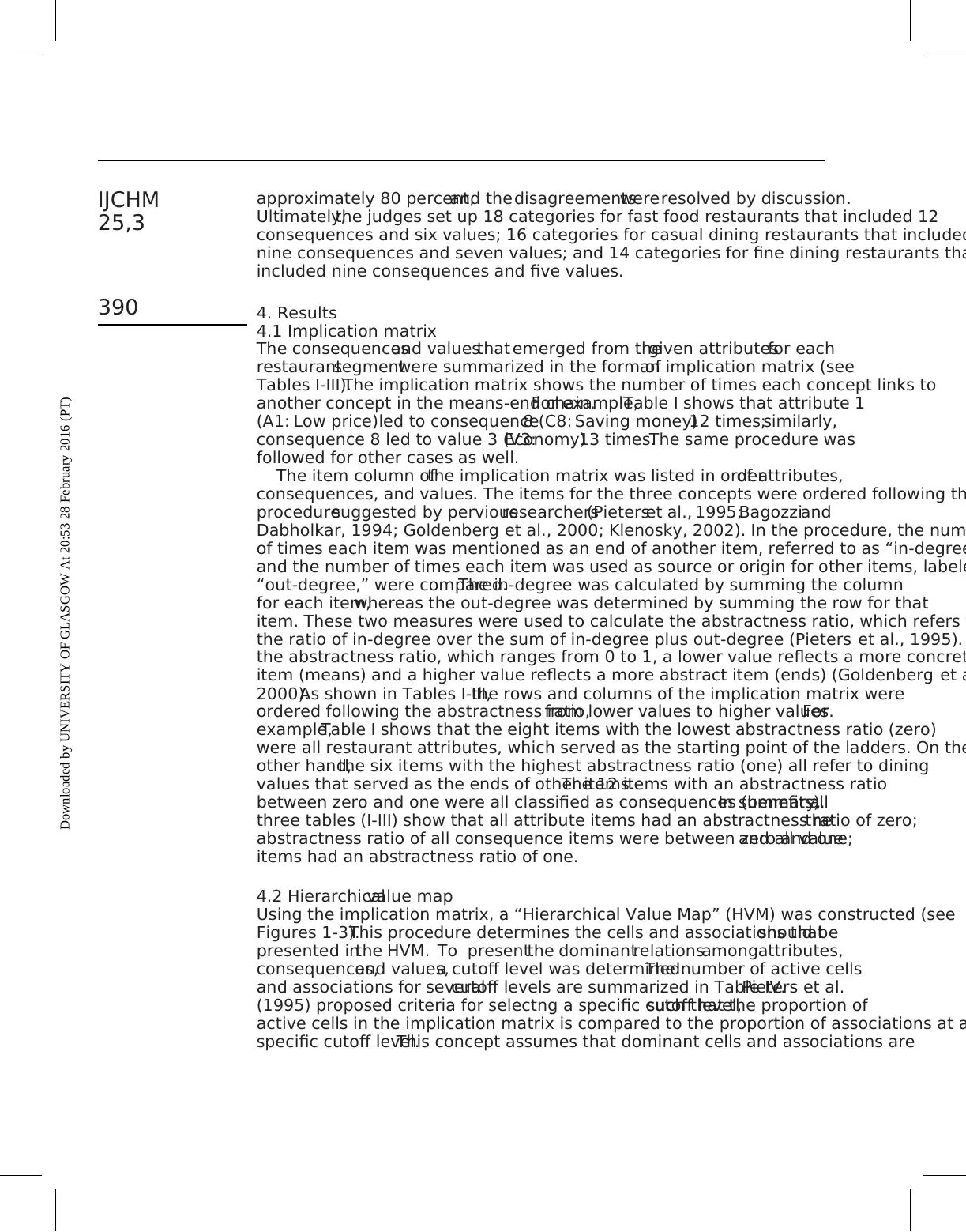
approximately 80 percent,and thedisagreementswereresolved by discussion.
Ultimately,the judges set up 18 categories for fast food restaurants that included 12
consequences and six values; 16 categories for casual dining restaurants that included
nine consequences and seven values; and 14 categories for fine dining restaurants tha
included nine consequences and five values.
4. Results
4.1 Implication matrix
The consequencesand valuesthat emerged from thegiven attributesfor each
restaurantsegmentwere summarized in the form ofan implication matrix (see
Tables I-III).The implication matrix shows the number of times each concept links to
another concept in the means-end chain.For example,Table I shows that attribute 1
(A1: Low price)led to consequence8 (C8: Saving money)12 times;similarly,
consequence 8 led to value 3 (V3:Economy)13 times.The same procedure was
followed for other cases as well.
The item column ofthe implication matrix was listed in orderof attributes,
consequences, and values. The items for the three concepts were ordered following th
proceduresuggested by perviousresearchers(Pieterset al., 1995;Bagozziand
Dabholkar, 1994; Goldenberg et al., 2000; Klenosky, 2002). In the procedure, the num
of times each item was mentioned as an end of another item, referred to as “in-degree
and the number of times each item was used as source or origin for other items, labele
“out-degree,” were compared.The in-degree was calculated by summing the column
for each item,whereas the out-degree was determined by summing the row for that
item. These two measures were used to calculate the abstractness ratio, which refers t
the ratio of in-degree over the sum of in-degree plus out-degree (Pieters et al., 1995).
the abstractness ratio, which ranges from 0 to 1, a lower value reflects a more concret
item (means) and a higher value reflects a more abstract item (ends) (Goldenberg et a
2000).As shown in Tables I-III,the rows and columns of the implication matrix were
ordered following the abstractness ratio,from lower values to higher values.For
example,Table I shows that the eight items with the lowest abstractness ratio (zero)
were all restaurant attributes, which served as the starting point of the ladders. On the
other hand,the six items with the highest abstractness ratio (one) all refer to dining
values that served as the ends of other items.The 12 items with an abstractness ratio
between zero and one were all classified as consequences (benefits).In summary,all
three tables (I-III) show that all attribute items had an abstractness ratio of zero;the
abstractness ratio of all consequence items were between zero and one;and all value
items had an abstractness ratio of one.
4.2 Hierarchicalvalue map
Using the implication matrix, a “Hierarchical Value Map” (HVM) was constructed (see
Figures 1-3).This procedure determines the cells and associations thatshould be
presented inthe HVM. To presentthe dominantrelationsamongattributes,
consequences,and values,a cutoff level was determined.The number of active cells
and associations for severalcutoff levels are summarized in Table IV.Pieters et al.
(1995) proposed criteria for selectng a specific cutoff level,such that the proportion of
active cells in the implication matrix is compared to the proportion of associations at a
specific cutoff level.This concept assumes that dominant cells and associations are
IJCHM
25,3
390
Downloaded by UNIVERSITY OF GLASGOW At 20:53 28 February 2016 (PT)
Ultimately,the judges set up 18 categories for fast food restaurants that included 12
consequences and six values; 16 categories for casual dining restaurants that included
nine consequences and seven values; and 14 categories for fine dining restaurants tha
included nine consequences and five values.
4. Results
4.1 Implication matrix
The consequencesand valuesthat emerged from thegiven attributesfor each
restaurantsegmentwere summarized in the form ofan implication matrix (see
Tables I-III).The implication matrix shows the number of times each concept links to
another concept in the means-end chain.For example,Table I shows that attribute 1
(A1: Low price)led to consequence8 (C8: Saving money)12 times;similarly,
consequence 8 led to value 3 (V3:Economy)13 times.The same procedure was
followed for other cases as well.
The item column ofthe implication matrix was listed in orderof attributes,
consequences, and values. The items for the three concepts were ordered following th
proceduresuggested by perviousresearchers(Pieterset al., 1995;Bagozziand
Dabholkar, 1994; Goldenberg et al., 2000; Klenosky, 2002). In the procedure, the num
of times each item was mentioned as an end of another item, referred to as “in-degree
and the number of times each item was used as source or origin for other items, labele
“out-degree,” were compared.The in-degree was calculated by summing the column
for each item,whereas the out-degree was determined by summing the row for that
item. These two measures were used to calculate the abstractness ratio, which refers t
the ratio of in-degree over the sum of in-degree plus out-degree (Pieters et al., 1995).
the abstractness ratio, which ranges from 0 to 1, a lower value reflects a more concret
item (means) and a higher value reflects a more abstract item (ends) (Goldenberg et a
2000).As shown in Tables I-III,the rows and columns of the implication matrix were
ordered following the abstractness ratio,from lower values to higher values.For
example,Table I shows that the eight items with the lowest abstractness ratio (zero)
were all restaurant attributes, which served as the starting point of the ladders. On the
other hand,the six items with the highest abstractness ratio (one) all refer to dining
values that served as the ends of other items.The 12 items with an abstractness ratio
between zero and one were all classified as consequences (benefits).In summary,all
three tables (I-III) show that all attribute items had an abstractness ratio of zero;the
abstractness ratio of all consequence items were between zero and one;and all value
items had an abstractness ratio of one.
4.2 Hierarchicalvalue map
Using the implication matrix, a “Hierarchical Value Map” (HVM) was constructed (see
Figures 1-3).This procedure determines the cells and associations thatshould be
presented inthe HVM. To presentthe dominantrelationsamongattributes,
consequences,and values,a cutoff level was determined.The number of active cells
and associations for severalcutoff levels are summarized in Table IV.Pieters et al.
(1995) proposed criteria for selectng a specific cutoff level,such that the proportion of
active cells in the implication matrix is compared to the proportion of associations at a
specific cutoff level.This concept assumes that dominant cells and associations are
IJCHM
25,3
390
Downloaded by UNIVERSITY OF GLASGOW At 20:53 28 February 2016 (PT)
⊘ This is a preview!⊘
Do you want full access?
Subscribe today to unlock all pages.

Trusted by 1+ million students worldwide
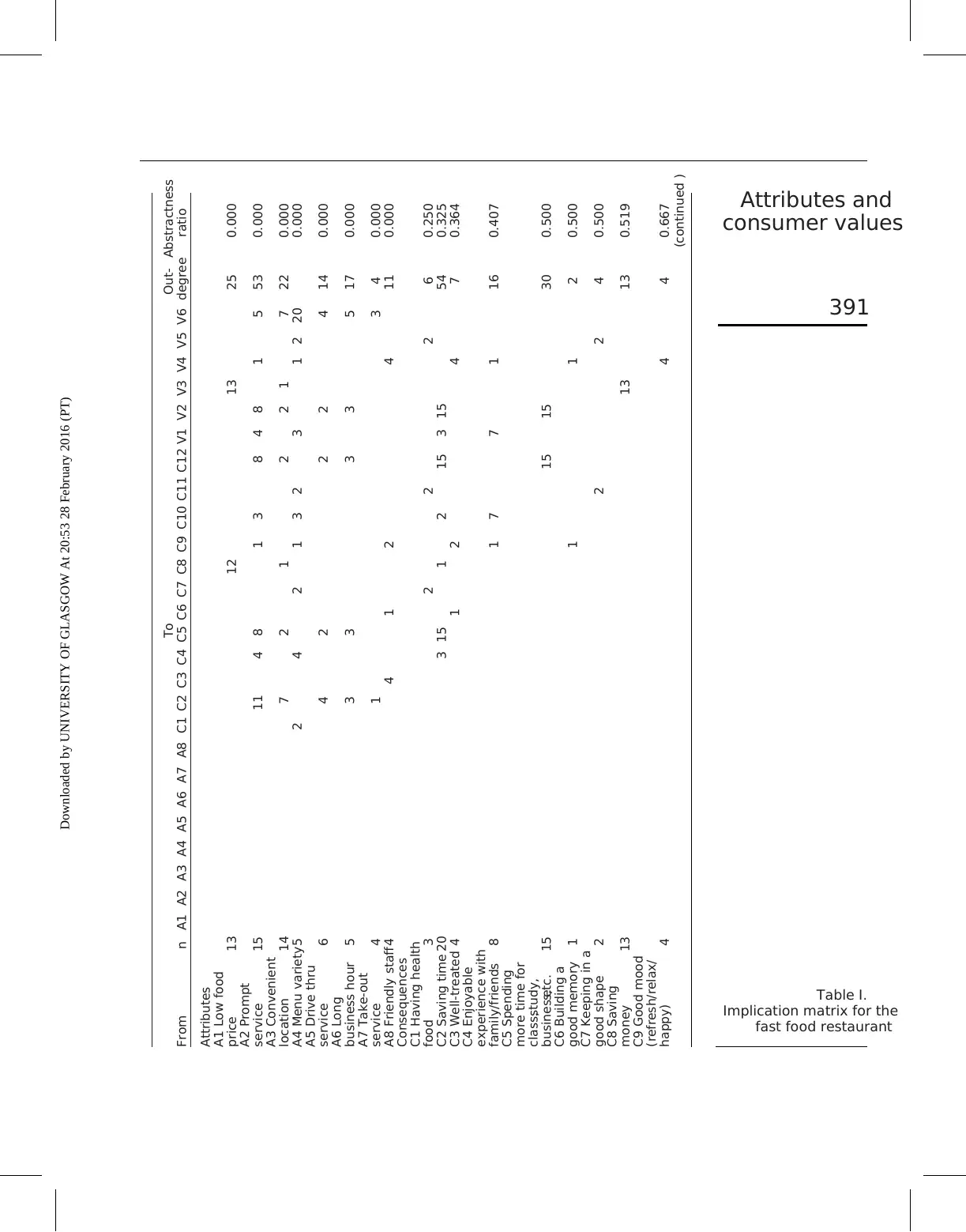
To
From n A1 A2 A3 A4 A5 A6 A7 A8 C1 C2 C3 C4 C5 C6 C7 C8 C9 C10 C11 C12 V1 V2 V3 V4 V5 V6
Out-
degree
Abstractness
ratio
Attributes
A1 Low food
price 13 12 13 25 0.000
A2 Prompt
service 15 11 4 8 1 3 8 4 8 1 5 53 0.000
A3 Convenient
location 14 7 2 1 2 2 1 7 22 0.000
A4 Menu variety5 2 4 2 1 3 2 3 1 2 20 0.000
A5 Drive thru
service 6 4 2 2 2 4 14 0.000
A6 Long
business hour 5 3 3 3 3 5 17 0.000
A7 Take-out
service 4 1 3 4 0.000
A8 Friendly staff4 4 1 2 4 11 0.000
Consequences
C1 Having health
food 3 2 2 2 6 0.250
C2 Saving time 20 3 15 1 2 15 3 15 54 0.325
C3 Well-treated 4 1 2 4 7 0.364
C4 Enjoyable
experience with
family/friends 8 1 7 7 1 16 0.407
C5 Spending
more time for
class,study,
business,etc. 15 15 15 30 0.500
C6 Building a
good memory 1 1 1 2 0.500
C7 Keeping in a
good shape 2 2 2 4 0.500
C8 Saving
money 13 13 13 0.519
C9 Good mood
(refresh/relax/
happy) 4 4 4 0.667
(continued )
Table I.
Implication matrix for the
fast food restaurant
Attributes and
consumer values
391
Downloaded by UNIVERSITY OF GLASGOW At 20:53 28 February 2016 (PT)
From n A1 A2 A3 A4 A5 A6 A7 A8 C1 C2 C3 C4 C5 C6 C7 C8 C9 C10 C11 C12 V1 V2 V3 V4 V5 V6
Out-
degree
Abstractness
ratio
Attributes
A1 Low food
price 13 12 13 25 0.000
A2 Prompt
service 15 11 4 8 1 3 8 4 8 1 5 53 0.000
A3 Convenient
location 14 7 2 1 2 2 1 7 22 0.000
A4 Menu variety5 2 4 2 1 3 2 3 1 2 20 0.000
A5 Drive thru
service 6 4 2 2 2 4 14 0.000
A6 Long
business hour 5 3 3 3 3 5 17 0.000
A7 Take-out
service 4 1 3 4 0.000
A8 Friendly staff4 4 1 2 4 11 0.000
Consequences
C1 Having health
food 3 2 2 2 6 0.250
C2 Saving time 20 3 15 1 2 15 3 15 54 0.325
C3 Well-treated 4 1 2 4 7 0.364
C4 Enjoyable
experience with
family/friends 8 1 7 7 1 16 0.407
C5 Spending
more time for
class,study,
business,etc. 15 15 15 30 0.500
C6 Building a
good memory 1 1 1 2 0.500
C7 Keeping in a
good shape 2 2 2 4 0.500
C8 Saving
money 13 13 13 0.519
C9 Good mood
(refresh/relax/
happy) 4 4 4 0.667
(continued )
Table I.
Implication matrix for the
fast food restaurant
Attributes and
consumer values
391
Downloaded by UNIVERSITY OF GLASGOW At 20:53 28 February 2016 (PT)
Paraphrase This Document
Need a fresh take? Get an instant paraphrase of this document with our AI Paraphraser
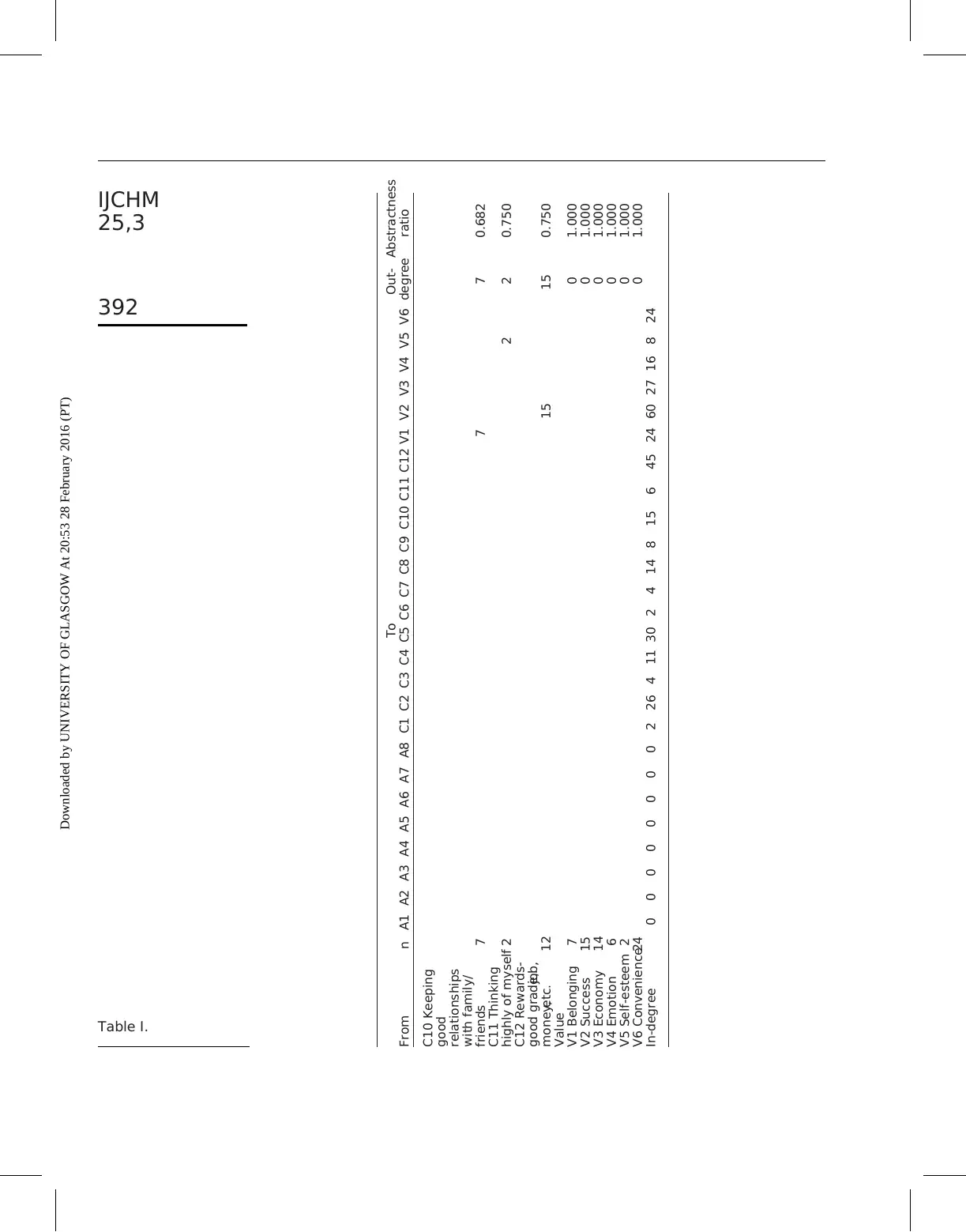
To
From n A1 A2 A3 A4 A5 A6 A7 A8 C1 C2 C3 C4 C5 C6 C7 C8 C9 C10 C11 C12 V1 V2 V3 V4 V5 V6
Out-
degree
Abstractness
ratio
C10 Keeping
good
relationships
with family/
friends 7 7 7 0.682
C11 Thinking
highly of myself 2 2 2 0.750
C12 Rewards-
good grade,job,
money,etc. 12 15 15 0.750
Value
V1 Belonging 7 0 1.000
V2 Success 15 0 1.000
V3 Economy 14 0 1.000
V4 Emotion 6 0 1.000
V5 Self-esteem 2 0 1.000
V6 Convenience24 0 1.000
In-degree 0 0 0 0 0 0 0 0 2 26 4 11 30 2 4 14 8 15 6 45 24 60 27 16 8 24
Table I.
IJCHM
25,3
392
Downloaded by UNIVERSITY OF GLASGOW At 20:53 28 February 2016 (PT)
From n A1 A2 A3 A4 A5 A6 A7 A8 C1 C2 C3 C4 C5 C6 C7 C8 C9 C10 C11 C12 V1 V2 V3 V4 V5 V6
Out-
degree
Abstractness
ratio
C10 Keeping
good
relationships
with family/
friends 7 7 7 0.682
C11 Thinking
highly of myself 2 2 2 0.750
C12 Rewards-
good grade,job,
money,etc. 12 15 15 0.750
Value
V1 Belonging 7 0 1.000
V2 Success 15 0 1.000
V3 Economy 14 0 1.000
V4 Emotion 6 0 1.000
V5 Self-esteem 2 0 1.000
V6 Convenience24 0 1.000
In-degree 0 0 0 0 0 0 0 0 2 26 4 11 30 2 4 14 8 15 6 45 24 60 27 16 8 24
Table I.
IJCHM
25,3
392
Downloaded by UNIVERSITY OF GLASGOW At 20:53 28 February 2016 (PT)
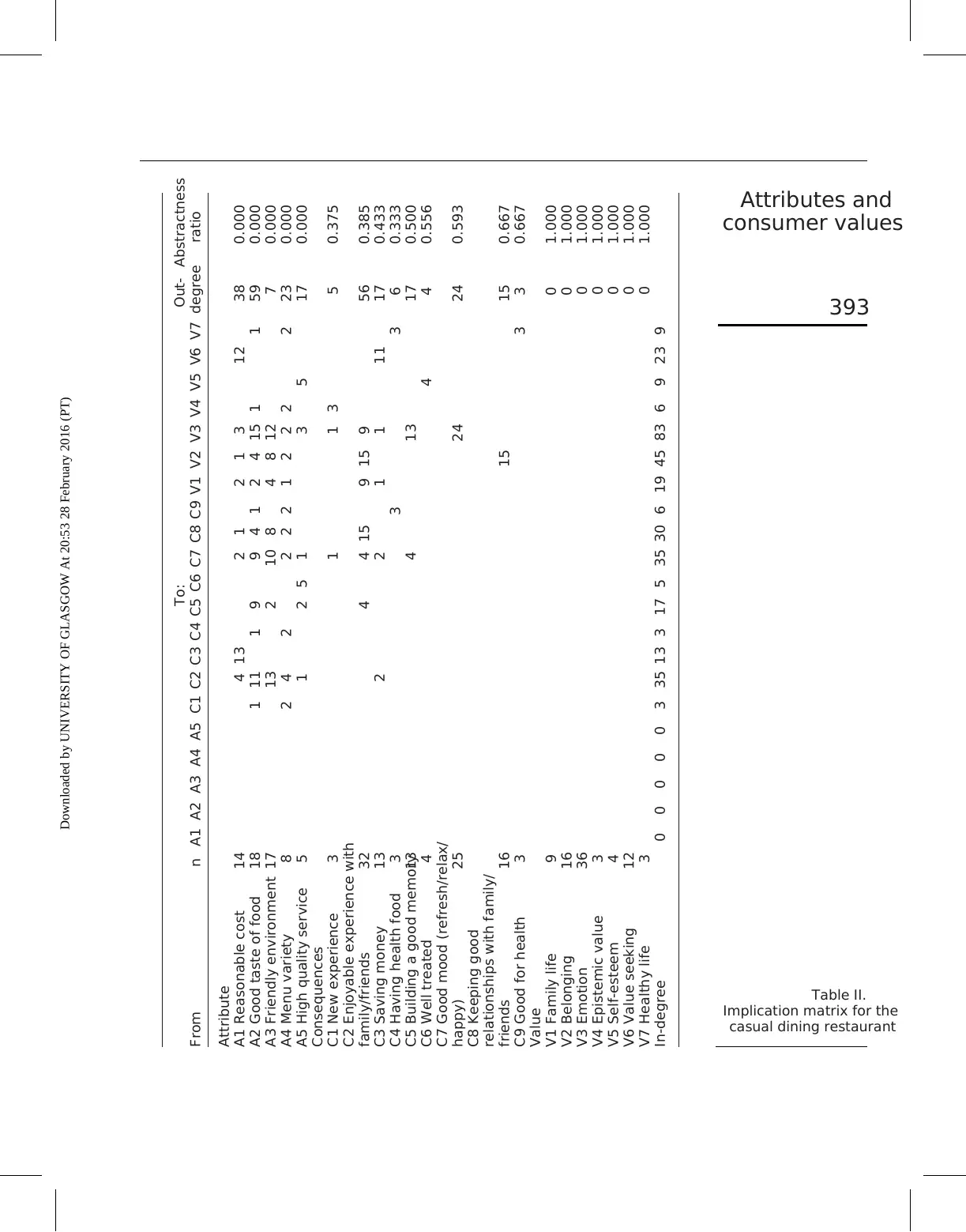
To:
From n A1 A2 A3 A4 A5 C1 C2 C3 C4 C5 C6 C7 C8 C9 V1 V2 V3 V4 V5 V6 V7
Out-
degree
Abstractness
ratio
Attribute
A1 Reasonable cost 14 4 13 2 1 2 1 3 12 38 0.000
A2 Good taste of food 18 1 11 1 9 9 4 1 2 4 15 1 1 59 0.000
A3 Friendly environment 17 13 2 10 8 4 8 12 7 0.000
A4 Menu variety 8 2 4 2 2 2 2 1 2 2 2 2 23 0.000
A5 High quality service 5 1 2 5 1 3 5 17 0.000
Consequences
C1 New experience 3 1 1 3 5 0.375
C2 Enjoyable experience with
family/friends 32 4 4 15 9 15 9 56 0.385
C3 Saving money 13 2 2 1 1 11 17 0.433
C4 Having health food 3 3 3 6 0.333
C5 Building a good memory13 4 13 17 0.500
C6 Well treated 4 4 4 0.556
C7 Good mood (refresh/relax/
happy) 25 24 24 0.593
C8 Keeping good
relationships with family/
friends 16 15 15 0.667
C9 Good for health 3 3 3 0.667
Value
V1 Family life 9 0 1.000
V2 Belonging 16 0 1.000
V3 Emotion 36 0 1.000
V4 Epistemic value 3 0 1.000
V5 Self-esteem 4 0 1.000
V6 Value seeking 12 0 1.000
V7 Healthy life 3 0 1.000
In-degree 0 0 0 0 0 3 35 13 3 17 5 35 30 6 19 45 83 6 9 23 9
Table II.
Implication matrix for the
casual dining restaurant
Attributes and
consumer values
393
Downloaded by UNIVERSITY OF GLASGOW At 20:53 28 February 2016 (PT)
From n A1 A2 A3 A4 A5 C1 C2 C3 C4 C5 C6 C7 C8 C9 V1 V2 V3 V4 V5 V6 V7
Out-
degree
Abstractness
ratio
Attribute
A1 Reasonable cost 14 4 13 2 1 2 1 3 12 38 0.000
A2 Good taste of food 18 1 11 1 9 9 4 1 2 4 15 1 1 59 0.000
A3 Friendly environment 17 13 2 10 8 4 8 12 7 0.000
A4 Menu variety 8 2 4 2 2 2 2 1 2 2 2 2 23 0.000
A5 High quality service 5 1 2 5 1 3 5 17 0.000
Consequences
C1 New experience 3 1 1 3 5 0.375
C2 Enjoyable experience with
family/friends 32 4 4 15 9 15 9 56 0.385
C3 Saving money 13 2 2 1 1 11 17 0.433
C4 Having health food 3 3 3 6 0.333
C5 Building a good memory13 4 13 17 0.500
C6 Well treated 4 4 4 0.556
C7 Good mood (refresh/relax/
happy) 25 24 24 0.593
C8 Keeping good
relationships with family/
friends 16 15 15 0.667
C9 Good for health 3 3 3 0.667
Value
V1 Family life 9 0 1.000
V2 Belonging 16 0 1.000
V3 Emotion 36 0 1.000
V4 Epistemic value 3 0 1.000
V5 Self-esteem 4 0 1.000
V6 Value seeking 12 0 1.000
V7 Healthy life 3 0 1.000
In-degree 0 0 0 0 0 3 35 13 3 17 5 35 30 6 19 45 83 6 9 23 9
Table II.
Implication matrix for the
casual dining restaurant
Attributes and
consumer values
393
Downloaded by UNIVERSITY OF GLASGOW At 20:53 28 February 2016 (PT)
⊘ This is a preview!⊘
Do you want full access?
Subscribe today to unlock all pages.

Trusted by 1+ million students worldwide
1 out of 29
Related Documents
Your All-in-One AI-Powered Toolkit for Academic Success.
+13062052269
info@desklib.com
Available 24*7 on WhatsApp / Email
![[object Object]](/_next/static/media/star-bottom.7253800d.svg)
Unlock your academic potential
Copyright © 2020–2025 A2Z Services. All Rights Reserved. Developed and managed by ZUCOL.





